Anna Russakoff • American University of Paris
Recommended citation: Anna Russakoff, Pain Quotidien: Images of Bakers in Medieval France, Different Visions: New Perspectives on Medieval Art 10 (2023). https://doi.org/10.61302/NAMV1837.
The Lord’s Prayer (Latin): “Pater noster, Qui es in coelis, Sancificetur nomen tuum, Fiat voluntas tuas, Sicut in coelo et in terra, Panem nostrum quoditianum da nobis hodie, Et dimitte nobis debita nostra, Sicut et nos dimittimus debotoribus nostris, Et ne nos inducas in tentationem, Sed libera nos a malo. Amen.” (English): “Our Father, who art in heaven, hallowed be thy name; thy kingdom come; thy will be done on earth as it is in heaven. Give us this day our daily bread; and forgive us our trespasses as we forgive those who trespass against us; and lead us not into temptation, but deliver us from evil. Amen.”[1]
“The belief that work in the medieval urban context was conceptually unproblematic – that it simply happened – has encouraged an oversimplified understanding of those who performed it.”[2] (Gervase Rosser, 1997)
Introduction
Bread has been an essential staple of the human diet since Neolithic times. Bread production flourished especially under the Romans. Although people could always produce bread at home, even grinding their own grain with handmills,[3] bakeries flourished in urban environments where demand was high, and baking itself became a fraught issue, often strictly controlled by local or royal authorities.[4] Although people of all social classes depended heavily on bread,[5] the type of bread you consumed would give a clear indication of where you stood in the social hierarchy, with the richest people partaking of soft, refined, lighter-colored breads, and poorer people eating harder, coarser, and darker-colored loaves.[6] Additionally, the cheaper rye often eaten by the lower classes could develop fungi, causing dangerous, long-standing alimentary diseases such as ergotism, also known as the feu de St. Antoine or the mal des ardents.[7] As Willy Jansen put it, “food defines us, and at the same time it differentiates ‘us’ from ‘them;’” it establishes religious, ethnic and class differences.[8] The most common type of bread, especially throughout the Middle Ages, was the miche ronde,[9] a simple round loaf; the famous elongated baguette only came into use in France centuries later.[10]
This essay will provide an overview of bread production beginning in Roman times, in order to examine the complex history of the medieval bakery, and to emphasize its connection to rural settings and peasant work. We will see how bakeries became an increasingly urban profession by the time Etienne Boileau wrote his famous thirteenth-century Livre de Métiers. Then we will consider how images of medieval bakers evolved, beginning with seals and shop signs. We will then turn to representations of bakers in the monumental arts. The bulk of the paper will focus on analyses of images of bakers in manuscript illuminations. Due to the plethora of images of bread-making, this survey is necessarily selective. While preserving a mostly chronological trajectory, I have tried to include the greatest diversity of gender and collaborative roles and to emphasize settings, clothing, gestures, and tools. At the end, we will complement the visual representations of these workers by examining two poems about bakers.
Ancient Rome
In Pompeii, there is evidence of 21 bakeries (or pistrina) for a population of approximately 10,000;[11] in Rome, there were 329 bakeries by the time of the Emperor Augustus.[12] Yet what constitutes a “bakery” has changed considerably over time. For example, in modern-day France, the combined boulangerie-pâtisserie boutiques are ubiquitous (bread and pastry products), something that would have been unheard of in the Middle Ages.[13] In Pompeii, we see that the bakery contained not only ovens, but also small grain mills that would have been pulled by animals or perhaps slaves;[14] within the 21 bakeries in Pompeii, 75 mills were found.[15] Millers were only separated from bakeries through the introduction of the much more effective watermill (Fig. 1), which was developed in Asia Minor in the first century BCE.[16] The baker-miller jobs were far from glamorous: according to Jan Theo Bakker, “working in the mills-bakeries was unattractive, to put it mildly.”[17]
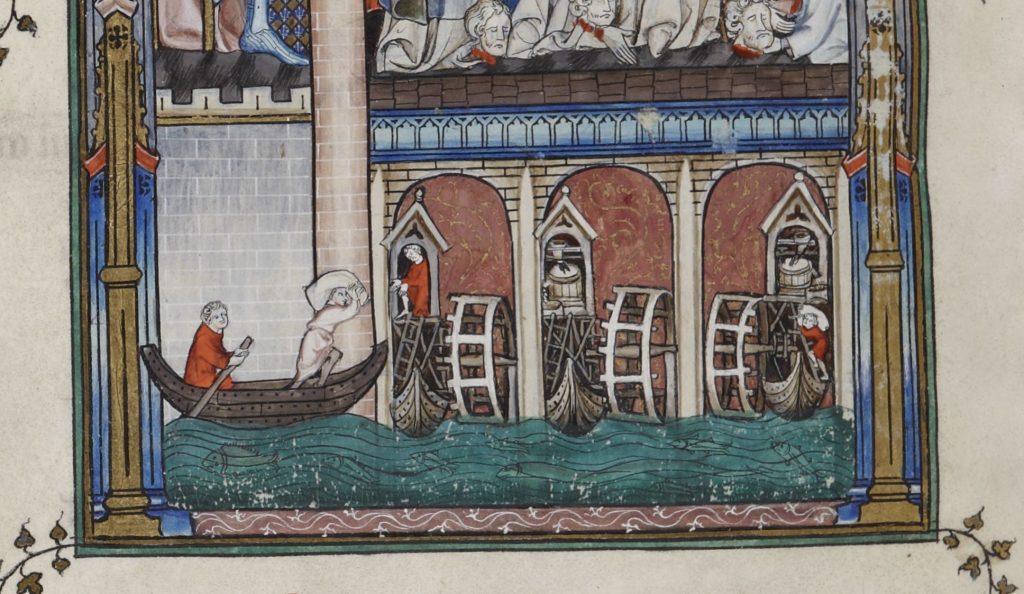
Fig. 1. Paris BnF fr. 2092 fol. 37v detail, water mills on the Seine, Vie de St. Denis.
In addition to actual archaeological remains of bakeries, there are also several representations of various aspects of bread production and distribution from Roman times. One of the few remaining frescoes relating to this theme is the so-called ‘sale of bread’ fresco in the House of the Baker or Casa del Forno in Pompeii (c. 79 CE, Fig. 2).[18] Here we see a bread distribution scene rather than any actual baking. One of the most important representations of baking itself can be found in relief sculpture on the Tomb of Eurysaces– a man originally from Greece who went on to become the richest baker in Rome–which is located near the prominent Porta Maggiore. These reliefs show multiple stages of bread production, from the negotiation and purchase of wheat to the preparation of the dough and baking (the latter two are depicted on the north side, Fig. 3) all the way through to the sale of the bread.[19]
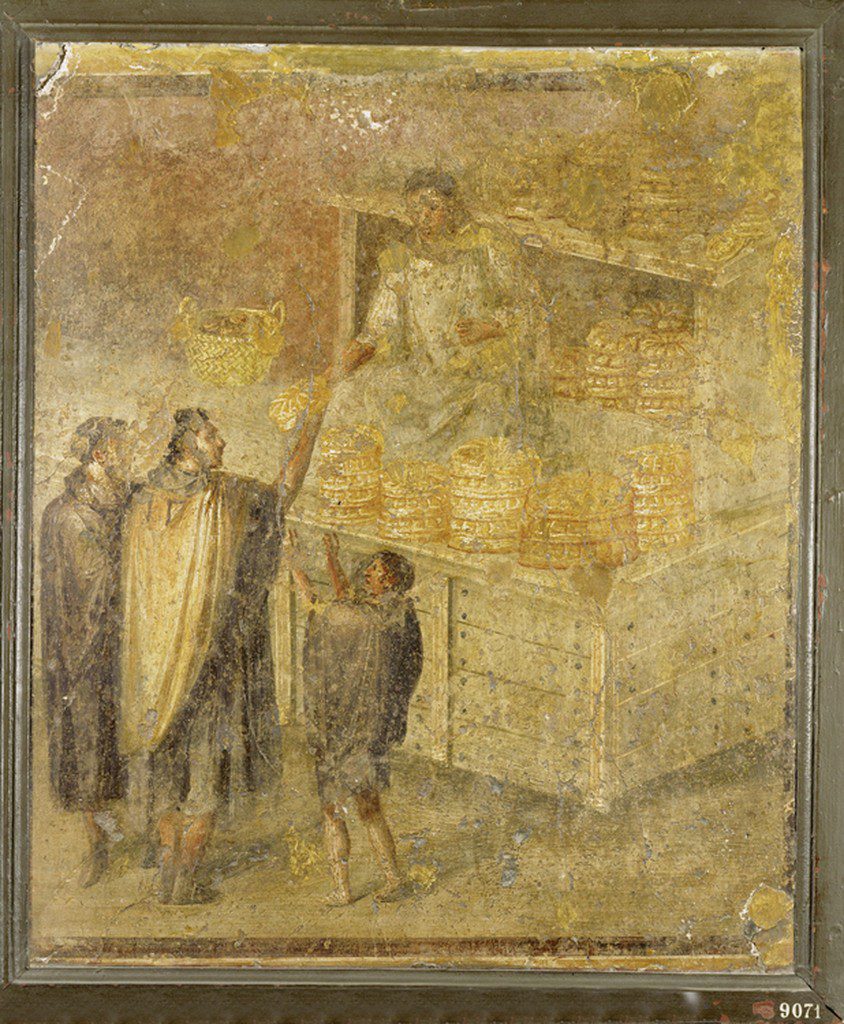
Fig. 2. Pompeii fresco, House of the Baker, bread distribution, 1st c. CE.

Fig. 3. Tomb of Eurysaces the Baker in Rome: north side, late 1st c. BCE.
Bread/Bakers in the Bible
Bread plays an incredibly significant role in the Bible. Adam, the patron saint of laborers, was told by God: “In the sweat of thy face shalt thou eat bread, till thou return unto the ground” (Genesis 3:19).[20] In Exodus 16, Manna falls miraculously from heaven (“I will rain down bread from Heaven for you”). In Leviticus 23, God tells Moses: “Out of all your dwellings, you shall offer two loaves of the firstfruits, or two tenths of leavened flour, which you shall bake for the firstfruits of the Lord” (Leviticus 23: 17-18).[21] The bread theme continues to flourish in the Gospels. Jesus states: “I am the bread of life” (John 6: 35, 48), and “I am the living bread which came down from heaven” (John 6: 41).[22] Jesus also fed the multitude with his miracles of the loaves and fishes (Matthew 14: 13-21, Mark 6: 31-44, Luke 9: 12-17 and John 6: 1-14), and famously broke bread during the Last Supper (Matthew 26: 17-29, Mark 14: 12-25, Luke 22: 7-38 and I Corinthians 11:23-25). Of the breaking of the bread at the Last Supper, Jesus declared: “this is my body, which is given for you. Do this for a commemoration of me” (Luke 22: 19). This statement, of course, paved the way for the rite of the Eucharistic Host.[23] Although the Eucharist was the central ceremony of the church already by the year 200 CE, and its symbolism remained of utmost importance to Christians throughout this period and beyond, it will not be considered in this essay since starting in the ninth century, the wafer was made of unleavened bread;[24] this essay will deal instead with the leavened bread that was a daily staple of medieval people’s diets. In later Biblical interpretations, Mary’s body was also associated with bread: notably, a bishop of Chartres, Pierre de Celle (1115?-1183), compared the Virgin’s womb to an oven,[25] a theme to which we will return. While bread is often referred to throughout the Bible, it is much more silent about bakers themselves.[26]
Rural to Urban, Mills to Ovens
In medieval France, the first evidence for public bakeries is from the eighth century; before that everyone baked their own bread at home. It was the multiplication of watermills starting in the tenth century[27] that provided large quantities of grain quickly enough that encouraged the development of bakeries. Windmills, a major technical innovation of the Middle Ages, started to appear in northern Europe starting around 1180.[28] In the countryside, the lord would construct a communal oven, or a four banal, where clients (even ones who had enough money to construct their own ovens) were required to bring their own dough for baking, for a fee (redevance), of course.[29] Although this practice of charging for the use of ovens was officially abolished in France on 17 July 1793,[30] we have undated photos that seem to reveal that their use by local residents continued throughout the nineteenth and even the early twentieth centuries (Fig. 4). Although peasants continued to produce their own bread for centuries, in towns baking very soon crystalized into a profession, or a métier.[31] But how could we define what a baker is? As we saw in ancient Rome, mills used to be found within bakeries, a practice that was largely abandoned in the Middle Ages. Yet flour had to be sifted,[32] dough kneaded, left to rise, baked, and then distributed or sold. The standard image that we will examine in this essay is of the fournier: the artisans who received the dough and provided the service of baking it in the oven, while also preparing the fire at the correct temperature, and keeping the oven clean. They had to make sure that the cooking time (cuisson) was correct, otherwise the bread could be too soft, or too hard and burned.[33] The fournier was in charge of using the baker’s peel to organize the entry and exit of bread dough from the oven—it was a dangerous work instrument that only fourniers were qualified to use, maintain and repair.[34] It was only in the thirteenth century that bakers obtained the right to even construct their own ovens.[35]
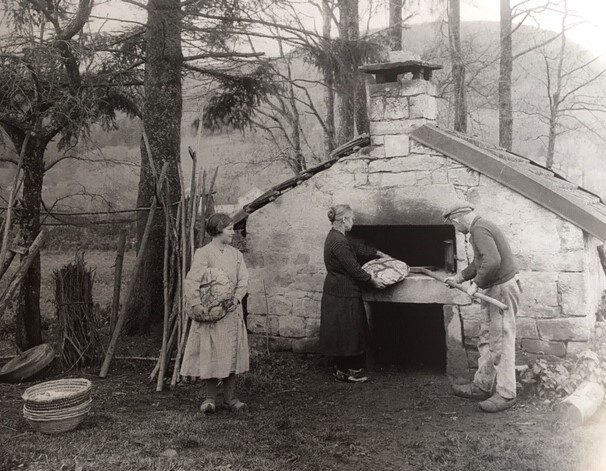
Fig. 4. ‘Four banal’, Normandy, ca 1900. From Jean-Michel Lecat, La grande histoire du pain et des boulangers des origines à nos jours (Paris, Lodi, 2006), page 58.
Etienne Boileau, Livres des Metiers (Talemeliers)
It is precisely at the moment that the iconography of the fournier begins to crystalize that the métier of the baker became codified in the urban context of Paris. The royal provost (prévôt royal) Etienne de Boileau[36] compiled the famous Livre des métiers in 1268, at the behest of King Louis IX (r. 1226-1270).[37] The baker’s guild had been one of the oldest Parisian corporations.[38] Bakers were first dedicated to St. Lazare, whom they believed could protect them against leprosy, which they feared they might be at risk for because of their constant exposure to heat and fire.[39] Without ever entirely renouncing their ties to St. Lazare, at some point the bakers’ headquarters moved to the Church of St. Honoré, who then became their major patron saint—he had been a baker prior to becoming a prelate.[40] According to Elizabeth Sears, the Livre des métiers was “among the earliest, most homogeneous and most enduring sets of guild statutes produced in any European city.”[41] The statute significantly begins with the corporation of the bakers (talemeliers), and it is the longest of the métiers, at 61 articles. The bakers were already controlled by the Grand Panetier, an office which was created earlier under King Philippe-Auguste (r. 1180-1223).[42]) Rather than providing us with vivid details of bakers’ working life and conditions, however, the statutes are concerned primarily with entry into guilds, apprenticeships,[43] the quality of materials that should be used, standards of production,[44] penalties for infractions, and especially codifying when the bakers could and could not work.[45] For example, bakers were forbidden to bake on festival days, which happened to be nearly a quarter of the year![46] Furthermore, bakers were not allowed to bake on the vigils of feasts unless the bread happened to be in the oven already at the moment the candles were lit.[47]
Seals and Shop Signs (Enseignes)
If a number of working norms for bakers were codified by the mid-thirteenth century, an official image for their guild still remained elusive. Corporations of workers in Paris adopted coats of arms from the twelfth century onwards, and corporate seals became particularly prominent by around the year 1200.[48] But it was only in the fifteenth century that the usage of coats of arms became generalized for corporations. Before then, lead tokens (méreaux de plomb) were used by the confrérie. The most common images were of St. Honoré standing on one side and an unnamed fournier placing bread into an oven on the other, so the two sides would represent both the patron of the corporation, and the tools most often used.[49] Yet the early seals for bakers varied, and could show the oven by itself, the baker’s peel by itself, or St. Honoré holding a baker’s peel with three round loaves of bread attached to it vertically (Figs. 5-7). In the Alsace region (and Switzerland and Germany), bakers’ seals often featured pretzels.[50] It was only in June 1467, with an ordinance called the Bannières, that blazons were finally regularized and given a legal consecration.[51] Finally towards the end of the seventeenth century, in the first official coats of arms of corporations of the Armorial Général of 1696, the bakers’ coat of arms is formally described as follows: ‘De sable, à deux pelles de four d’argent passes en sautoir, chacune chargée de trois pains de gueules.’[52] Thus the seals eventually adopted the baker’s peel with three loaves of bread as their official visual image, although they did not settle on showing an actual worker manipulating it. According to Brigitte Bedos-Rezak, seals tended towards including very limited iconographic elements, since they were intended for repetitive use under diverse circumstances: “it had to display the most essential elements of a sealer’s identity.”[53]
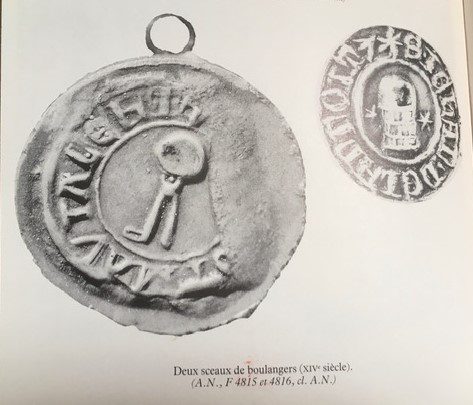
Fig. 5. Bakers’ seals, Françoise Desportes, Le pain au moyen âge (Paris: Orban, 1987) (all images between pages 108 and 109).
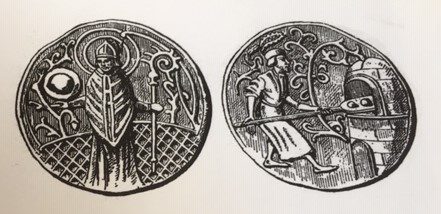
Fig. 6. Bakers’ seals, St. Honoré and a ‘fournier’. Jean-Michel Lecat, La grande histoire du pain et des boulangers des origines à nos jours (Paris, Lodi, 2006), page 71.
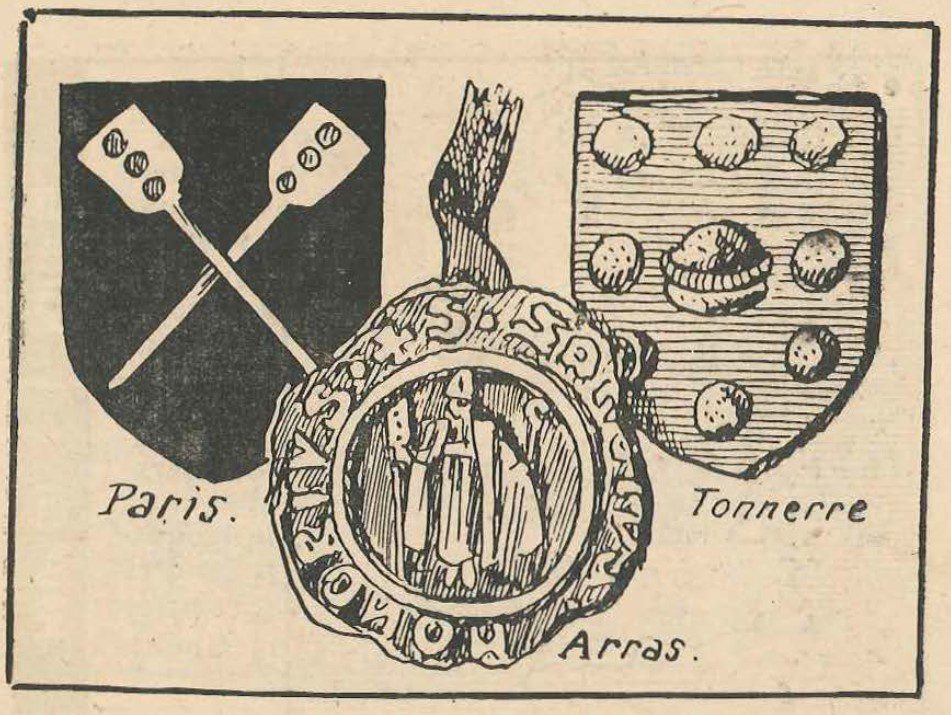
Fig. 7. Bakers’ banners, Alfred Carlier, Histoire des boulangers (Cannes : Aegitna, Bibliothèque de travail 63, 1949), page 3.
Since seals did not codify the most prevalent image of the baker in action, but preferred to isolate just the tools, another area to consider would be shop signs (enseignes), since outside even in modern bakeries the fournier image remains prevalent in signage (Figs. 8-9). Shop signs also came to the fore in the thirteenth century, became more numerous in the fourteenth century, and then finally became generalized in the fifteenth century, usually in the hanging form.[54] They could be sculpted in stone or terracotta, and more rarely made of metal, and were most likely polychromed. Probably many of them were of painted wood, and unfortunately most do not survive.[55] Generally, it was the merchandise itself that was featured on the shop sign rather than the workers.[56] The earliest shop sign I could find that is possibly from a bakery is a golden sheaf of wheat from the eighteenth century, now at the newly-renovated Carnavalet museum in Paris (Fig. 10).
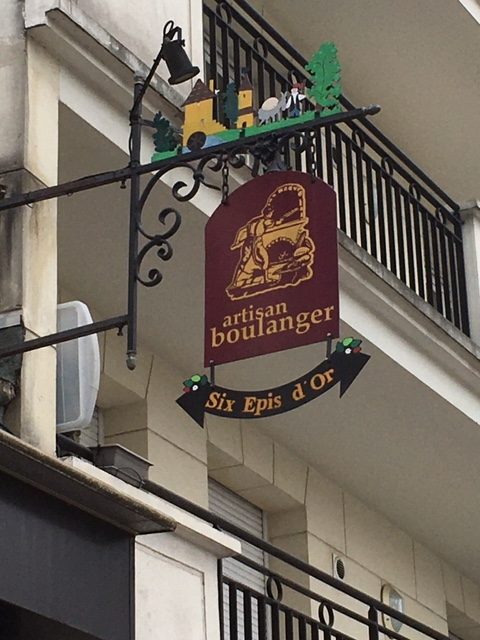
Figs. 8. Signage for local bakeries in Paris area, France, 2021. [Photos: author]
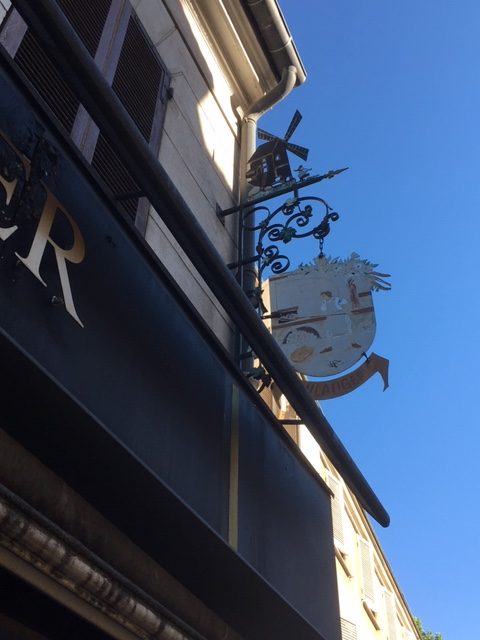
Figs. 9. Signage for local bakeries in Paris area, France, 2021. [Photos: author]
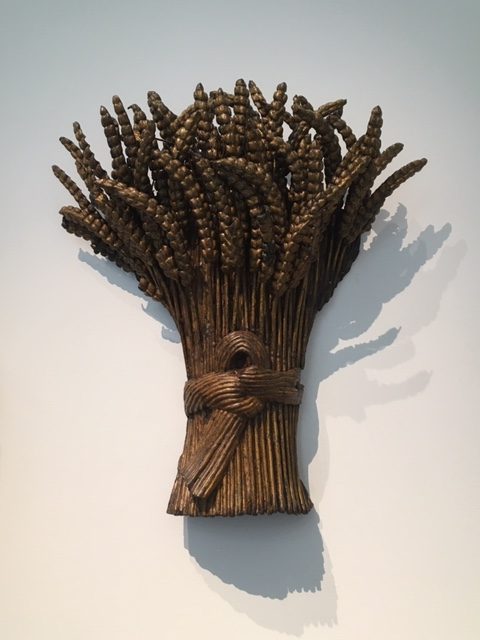
Fig. 10. Golden Sheaf, shop sign, Musée Carnavalet, Paris, 18th c., [photo: author]
Monumental Arts: Sculpture and Stained Glass
From the surviving evidence, the image of the fournier does not seem to have been codified in either medieval corporate seals or on shop signs. Starting in the twelfth century, we begin to see calendar scenes in monumental sculpture. Even though they are often formulaic and abbreviated in this medium, the calendar cycles provide some initial visual material about seasonal work.[57] Although calendar scenes date back at least to ancient Greece in the second century BCE with the signs of the zodiac, medieval calendar cycles, which will be discussed in more detail below, favored a closer relation to the earth, emphasizing the relationship to the labors of the months.[58] In monumental sculpture, interpretations of labors of the months often remain elusive, since the condition is frequently worn.[59] The only depiction of a baker in medieval French sculpture that I found was at the Cathedral of Notre-Dame at Senlis (Fig. 11). Here a relief sculpture on the pedestal of one of the portals points to an indirect reference to the occupation of baking: a figure stooping towards an oven for the month of December.[60]
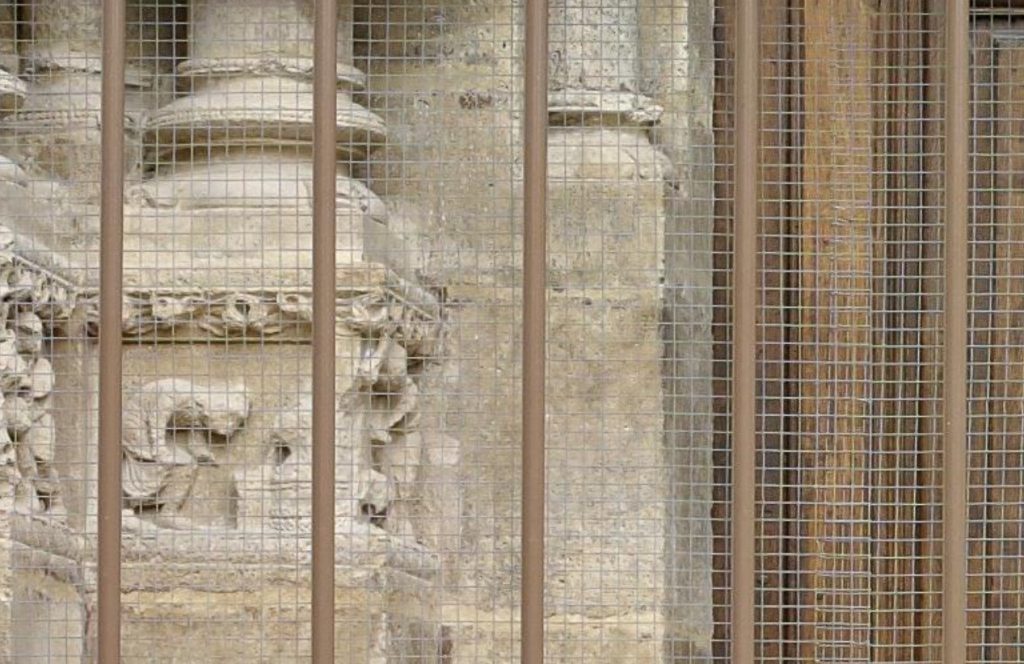
Fig. 11. Cathedral of Senlis sculpture with baker. Western façade, central portal.
There are many more surviving images of bakers in stained glass windows. Jane Welch Williams has studied the extensive bread imagery in the stained-glass program at Chartres Cathedral. She has noted that no other French Cathedral features as much bread.[61] Pierre de Celle (1115?-1183), a Chartres bishop, was also the author of the Liber de Panibus in ca. 1175.[62] Indeed, bread was the primary product of the Beauce region, which is surrounded (to this day) by wheat fields. The bishop and the chapter were the largest grain growers in the diocese, and the Loëns granary, rebuilt in the thirteenth century (and now home to a stained-glass museum), stored the highest quality grains from the diocesan farms. Bread also continued to be used in lieu of money at Chartres (for taxes, obligations), even after the establishment of the money economy.[63] The extensive bread imagery in the stained-glass program at Chartres includes baskets of bread, selling loaves, bakers preparing loaves for baking, kneading dough, and shaping loaves for the oven.[64]
Interestingly, the iconography of the fournier does not appear at Chartres, although it does in thirteenth-century windows at Bourges and Le Mans. The window of St. John the Evangelist at the Cathedral of St. Etienne at Bourges (Fig. 12), contemporary with the lower windows depicting the trades at Chartres, is part of a series of trade windows in the ambulatory, and there are two bread scenes in the bottom register. One of them depicts a baker holding a peel with a round loaf of bread in front of an oven.[65] At the Cathedral of St. Julien at Le Mans, slightly later from ca. 1265, there are also depictions of baking scenes (Fig. 13).[66] These four images can be found in the lowest register of four lancets in the upper southern choir clerestory (window #212): here men measure grain, prepare loaves, bake them in an oven, and set them out on a stall table for sale.[67]

Fig. 12. Bourges – stained glass. Window 22. The bakers with a client, and at work, ca. 1210-1215.
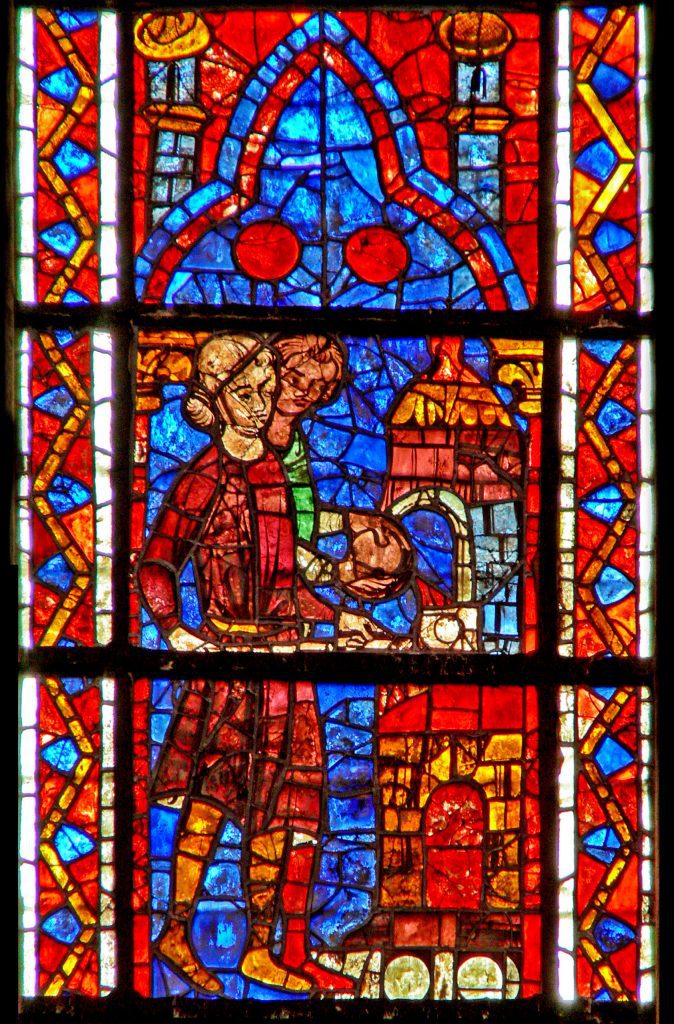
Fig. 13. Le Mans stained glass – window 212, detail of a fournier, ca. 1265.
Calendar Cycles in Illuminated Manuscripts: Month of December
Thus, there are only scattered examples of images of bakers in the monumental arts. It is the calendar cycles in illuminated manuscripts which show us the most robust development of the typical iconography of the baker.[68] As mentioned before, the Middle Ages inherited the calendar cycle from Greco-Roman art.[69] From antiquity, the calendar scenes would usually show single figures enclosed by frames, only referring to occupations through attributes.[70] The Carolingian period witnessed a revival of calendar imagery. The earliest known medieval calendar cycle depicting labors is now in Vienna ONB ms. 387 fol. 90r, the Carmina salisburgensia, illuminated between 809 and 821 at Salzburg (Fig. 14).[71] Here the month of December is represented by a man killing a boar, by far the most prevalent illustration for that month, followed by the baker. This association between the two activities is not as unexpected as it might seem; bakers in medieval France frequently raised pigs, even in urban contexts.[72]
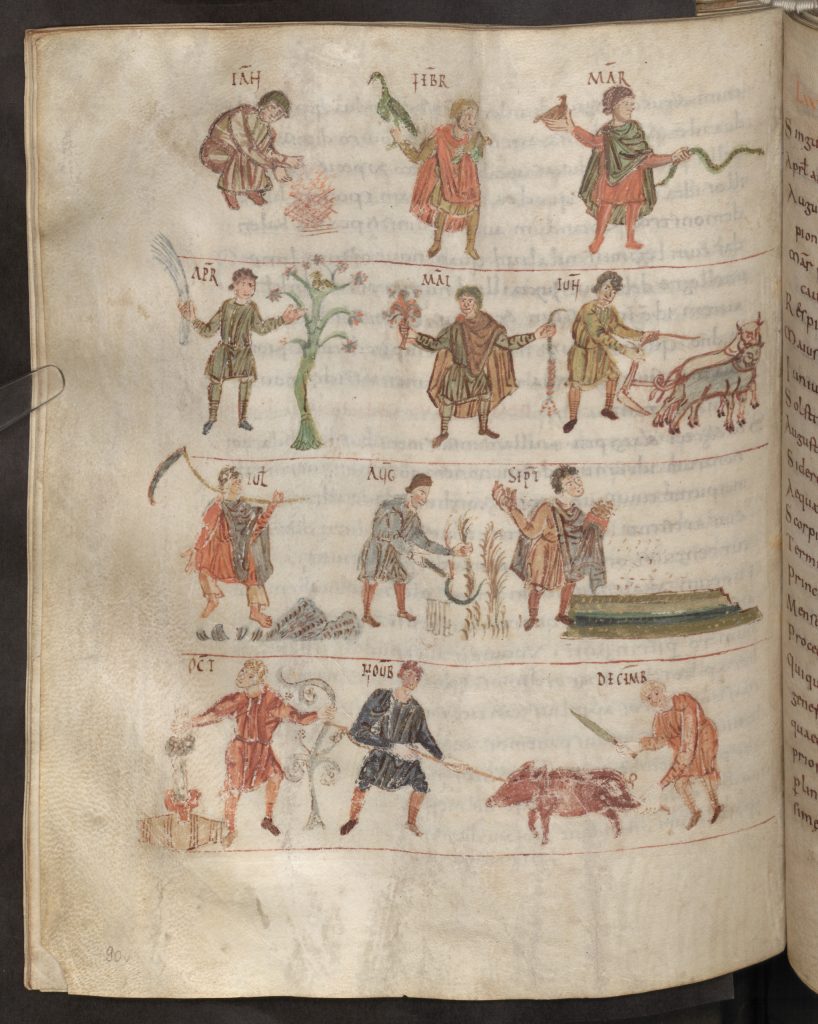
Fig. 14. Vienna ONB 387, fol. 90r. Labors of the month.
The sequence of twelve monthly activities are almost exclusively rural, and by the end of the Middle Ages could be found in almost any medium.[73] The core of the calendar year focuses on the growing and producing the cereal crops: ploughing, sowing, reaping, threshing.[74] The calendars also tend to show peasants in domestic settings in the winter months.[75] Due to the coldness of the season, the standard scenes for December tended to be slaughtering a pig, roasting a pig or baking, since in France and Flanders, where the majority of these images were created, winter is mostly spent indoors.[76] These calendar scenes in illuminated manuscripts therefore present the richest corpus of material from which to study not only the essential production of grain, but also the iconography of the baker.
Alexander and Camille. Representations of Peasants: Virtuous vs. Lazy
Two crucial articles about representations of peasant labors written within three years of each other were by Michael Camille (1987) and Jonathan Alexander (1990).[77] Both authors emphasized the disconnect in social class between the wealthy patrons who commissioned illuminated manuscripts, and the peasants who are represented performing the labors. They importantly challenged the view that these calendar scenes offer an idyllic and unproblematic views of rural life,[78] masking the often back-breaking work that peasants were forced to perform. Camille considers the plough to be “the most important machinery in the feudal economy,” but notes that “[i]lliterate peasants have no power over how they are represented.”[79] Both authors drew attention to the idea of the virtuous ploughman shown hard at work;[80] this creates a sharp ideological contrast with the lazy peasant shown asleep, as emphasized by Alexander, a state in which any work is simply impossible.[81] These essays, and especially the attention they draw to clothing, postures, and actions as indicators of social class, lay the foundation for any critical study of images of workers.
Thirteenth-Century Calendar Scenes. Fourniers
The first manuscripts representing bakers in calendar scenes appear in thirteenth-century Psalters. They tend to provide very little context, so it becomes impossible to determine if these are peasants working at a wealthy person’s home in the countryside,[82] or part of the workforce of the increasingly codified profession of urban bakers. The fournier image is by far the most prevalent already in the thirteenth century. Usually we see a man alone, either placing bread into the oven or removing it on a peel. If it often difficult to determine whether he is inserting or removing the loaves – the color of the bread can sometimes help.
In an English Psalter from Reading Abbey from ca. 1250 (NY PML M. 103), in a circular format on fol. 8v (Fig. 15. New York, PML M. 103, fol. 8v. English Psalter from Reading Abbey, ca. 1250), we see a tall oven on the right whose upper portion resembles a late medieval tower; there is a table in front of it with three round loaves of bread (miches). The baker is depicted in the center in an active, forward gesture: with a long baker’s peel, he places one loaf of bread into the oven (the bread loaves on the table seem slightly darker, so this would also indicate that he’s putting it in to bake). He is shown in full profile, with curly hair and a beard, and his cheeks seem slightly flushed from the heat.
Likewise, in the Katherine Psalter from Thérouanne, France from ca. 1260-70 (NY PML M. 97), on fol. 6v (Fig. 16. New York PML M. 97 fol. 6v. Katherine Psalter, Thérouanne, France, 1260-70), in a rectangular frame with a triangular top decorated with balls on the upper corners, we see another fournier working alone. The oven (much smaller this time) is pressed against the right, and again the big emphasis in the center is on the fournier himself, in the same active, central position. There is no table in front of the oven, so we just see one round miche on the peel, looking very white so it is probably about to enter the oven for baking. Wearing a typical coif,[83] the fournier is in a slightly bent posture, but otherwise there is no indication that there is any particular effort being expended.
In the St. Omer Psalter from 1270-90 (Oxford Bodleian Douce MS 49) on fol. 9v (Fig. 17), we see the same shape of a small vertical rectangle topped with a triangular shape (decorated with a single ball on the top). The oven here is again on the right, with a round brick base, and the vault-like oven on top. The fournier again occupies the central space. He wears the coif tied around the chin, with a little bit of hair showing. The bread here is not visible at all, focusing our attention wholly on the actions of the baker. Again, other than the slightly bent/stooping posture, no physical effort is shown, and he is fully clothed.
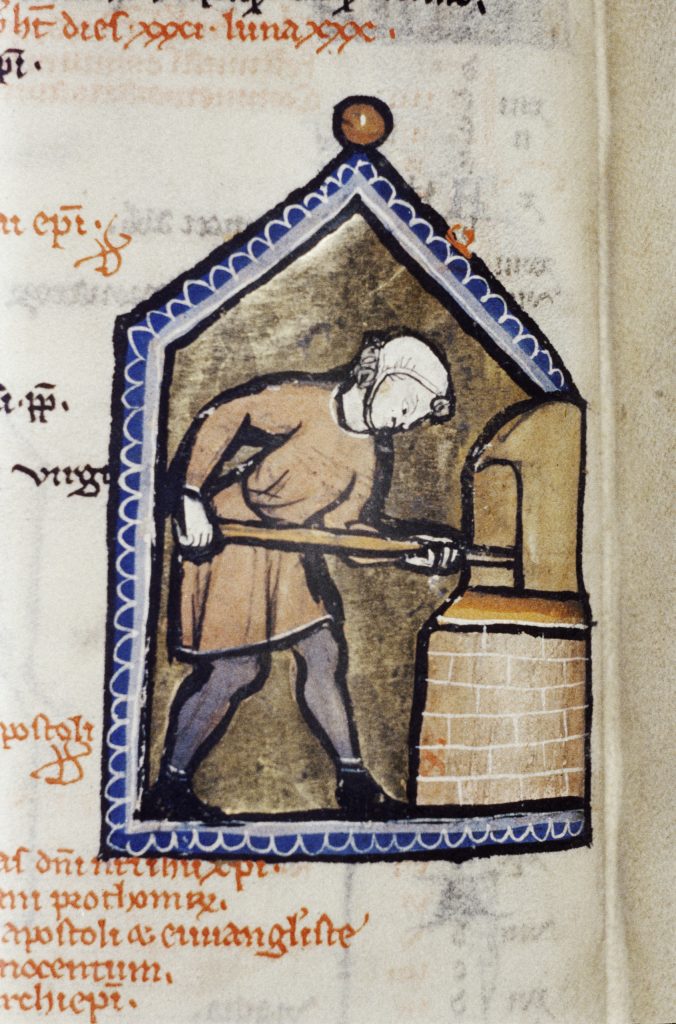
Fig. 17. Oxford, Bodleian Library Douce MS 49, fol. 9v. The St. Omer Psalter, 1270-90.
Finally, a Franciscan Psalter from Northern France, probably Thérouanne from ca. 1285 (now in Paris BnF lat. 1076)[84] shows us on folio 6v (Fig. 18) the most sophisticated architectural frame so far for the miniature, with trefoil arches, gables, and multiple pinnacles in blue, pink, and gold, topped in some cases with green leaf-decorations. This is our first example that acknowledges the intensity of the heat of the oven, and how this temperature might affect the worker. The oven is again on the right, with a brick circular base, and the typical round, vaulted top. The mouth of the oven is even outlined in gold. This is the first time we see actual orange flames within the oven. The fournier places the miche in the oven on a peel: the fully circular shape and white color indicate that he is most likely placing the dough inside for baking. The fournier, again fully in profile, is dressed in an outfit that is finally more adapted to uncomfortably high temperatures: he is barefoot, without stockings, and is bare-chested. He is only wearing a breechcloth wrapped around his waist, and the white coif tied around his head, with some of his hair still visible in back.
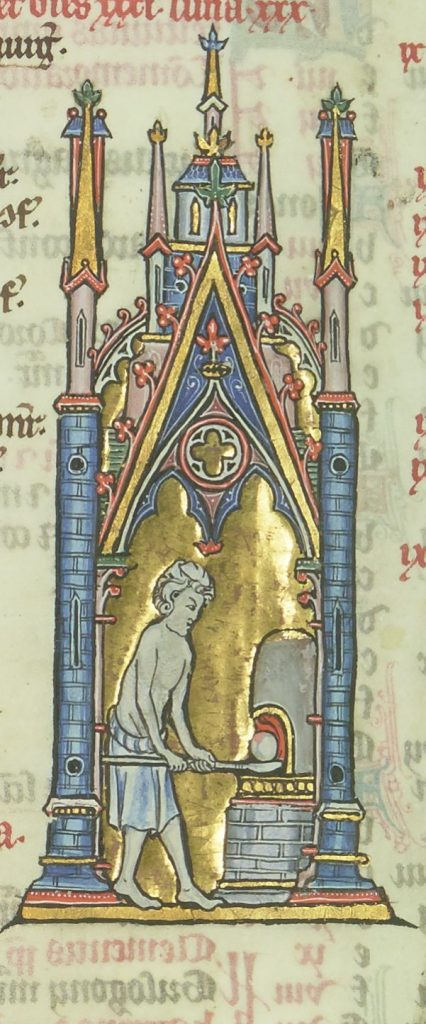
Fig. 18. Paris BnF lat. 1076, fol. 6v. Franciscan Psalter, northern France, probably Thérouanne, ca. 1285.
Fourteenth-Century Expansion
In the fourteenth century, we start to see bakers depicted in Books of Hours in addition to Psalters, and also in secular manuscripts. Other exciting developments in the iconography include more collaborative tasks, more female workers,[85] the depiction of bakers in marginal areas, and the introduction of animal bakers.[86] This section will stray slightly from chronological order in order to highlight these themes.
The first non-devotional manuscript we will consider is the Smithfield Decretals, now in London BL Royal 10 E IV, from ca. 1340, southern France, probably Toulouse.[87] This is a canon law book, and our first view of bakers in lower marginal areas, on folios 145r-145v (Figs. 19-20); these scenes do not relate directly to the text above. This is also our first collaborative scene, here between two men. In fol. 145r, the bearded man on the left carries a basket (full of dough?). A bearded man on the right looks back towards him, while placing a round white miche into a dark grey oven. No flames are visible, both men are fully dressed, and there is no visual indication of the heat. On fol. 145v, the bearded man on the left places cooked round loaves of bread into a basket, giving us one of our first glimpses into another important part of the bread-making process: distribution. The bearded man on the right holds a peel most likely to remove bread from the oven, in which we now see some flames. His body is arched away from the oven, probably in order to avoid the heat. He is wearing the typical tight, white coif, and is fully dressed.

Fig. 19. Smithfield Decretals. London BL Royal MS 10 E IV, ca. 1340, southern France, probably Toulouse, fol. 145r.

Fig. 20. Smithfield Decretals. London BL Royal MS 10 E IV, ca. 1340, southern France, probably Toulouse, fol. 145v.
In our next example is our first Book of Hours from Cambrai, Belgium from ca. 1300-1310 (Walters MS 88); here we see men and women collaborating for the first time on fols. 14v and 15r (Figs. 21-22). In this Book of Hours that originally had a female owner,[88] men and women collaborate in different stages of the baking process. Interestingly, we see the stages taking place out of order: on fol. 14v a man and a woman place dough into an oven on a peel, and on fol. 15r, we see the preparation of the dough. On fol. 15r, two fully clothed women knead in a large trough (pétrin); the one in the center has one hand in the flour and the other touching the water that is being poured by the woman on the left. Both women are wearing full-length dresses with long sleeves and white cloth head coverings. On fol. 14v, both the man and the woman holding the peel are fully dressed. The man holds the peel on the left, further away from the oven, and wears the typical tight, white coif. His female collaborator is closer to the opening of the oven, pushing two white round loaves inside. She wears a white head covering; unlike her husband’s small coif, this covering goes all the way around her head, neck, and shoulders. The oven itself is very schematic, and no flames are visible. No one on either folio is dressed appropriately for the extreme heat.
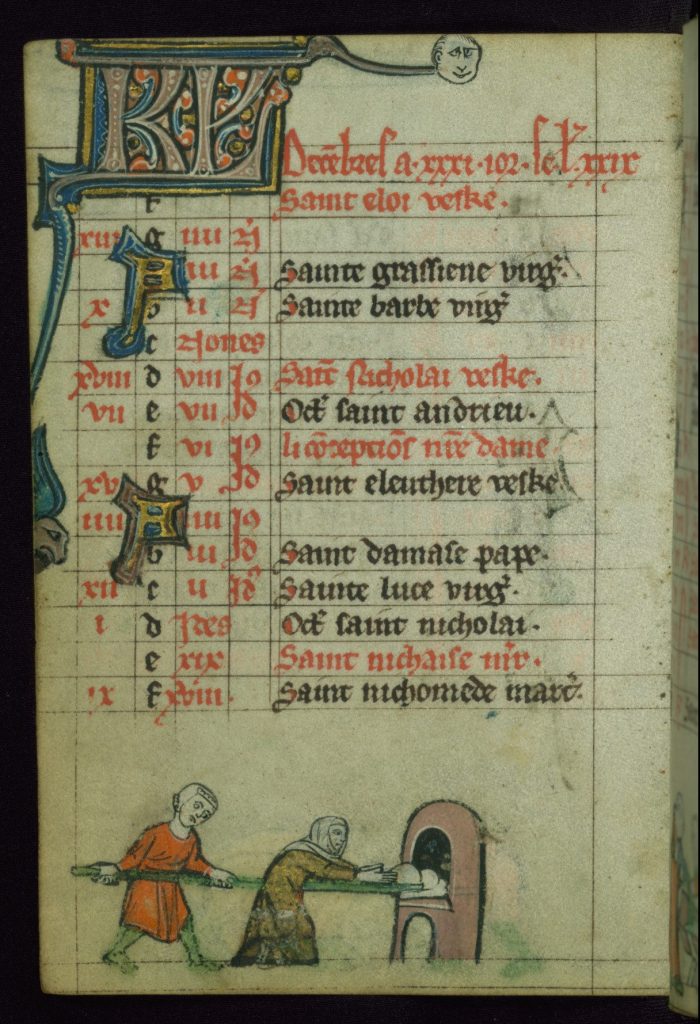
Fig. 21. Baltimore Walters Museum MS 88, Book of Hours, Belgium, Cambrai, ca. 1300-1310, fol. 14v.
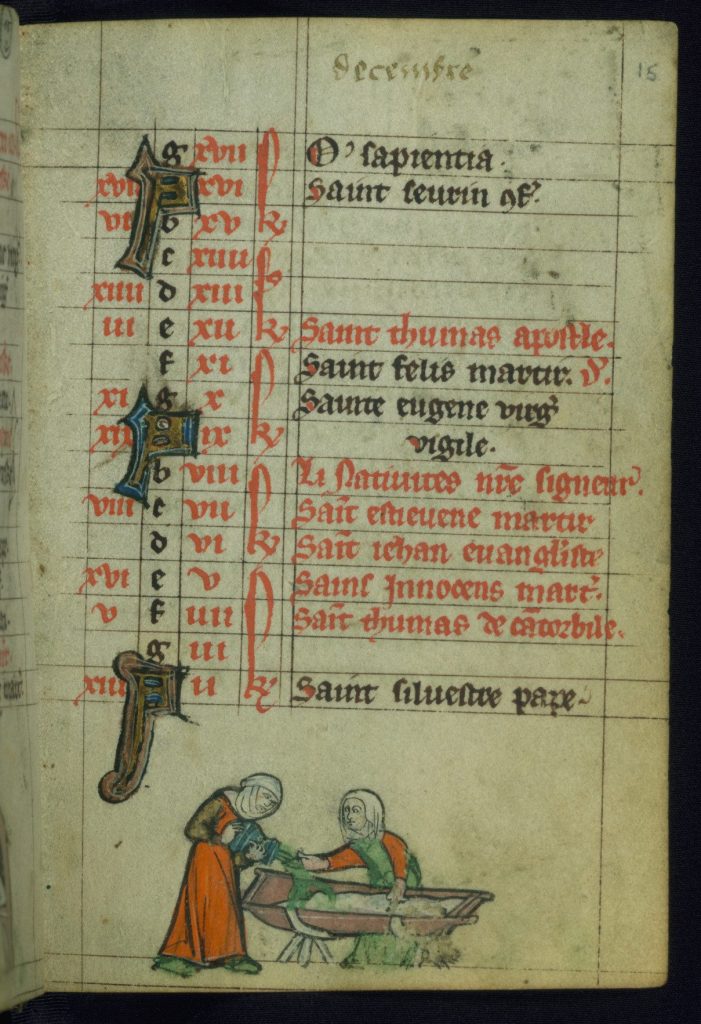
Fig. 22. Baltimore Walters Museum MS 88, Book of Hours, Belgium, Cambrai, ca. 1300-1310, fol. 15r.
We see more male-female collaboration in a Portable Psalter originally from Ghent from 1320-30 (now in Oxford, Bodleian Douce MS 5);[89] it features the typical round vaulted oven breaking out of the frame of the rectangular miniature (fol. 8r; Fig. 23). The oven is on the right, we see what looks like a table attached, a hovering flat-shaped bowl beneath it, and orange flames on the bottom. The fournier is dressed in a manner that is more suitable for high temperatures. Barefoot, no stockings, bare chested – he is only wearing a breechcloth tied around his waist, and this time a blue hat that is larger and rounder than the typical tight white coif that we had seen in previous examples. He is raising his hand as if to shield or protect himself from the heat, while placing (or removing) a round miche into/from the oven on a baker’s peel. This time, he is not alone: we see two women working on the table to the left. One is rolling out the dough, and another is forming dough into the round shape of the miche. The women glance at each other, and neither one is dressed for extremely high temperatures.

Fig. 23. Oxford Bodleian Douce MS 5, fol. 8r. Ghent, 1320-30. Portable Psalter.
One of our most fascinating examples is currently divided between two locations: the Hours of St. Omer, in New York (PML M. 754) and in London (BL Add. 36684).[90] This Book of Hours contains some of the most unusual and provocative images of bakers and ovens.[91] We have bare-chested workers, our first animal bakers, and our clearest expressions so far of the sexual implications of the oven. The oven has long been associated with the womb,[92] and the man holding the long peel and inserting it inside the oven has sexual implications that find their fullest expression here. The marginal imagery of this manuscript fully exploits the sexual innuendos of the oven as orifice. This manuscript was made for a woman, most likely a lady named Marguerite.[93] Although Judith Steinhoff plausibly proposed that the oven could indicate the original female owner’s desire for pregnancy, the explicitly homoerotic themes seem to transform the oven beyond its symbolism as a womb, into an erotic orifice that is not necessarily heterosexual, which might have more to do with the artist’s interests rather than the desire of the patron.[94]
In the London branch of the Hours of St. Omer (BL Add. 36684, fol. 12v, Fig. 24), we see another bare-chested baker. Within an elaborate architectural frame, similar to the one we saw in the Franciscan Psalter (Paris BnF lat. 1076, fol. 6v), the brick vaulted oven is on the right. The fournier in the center is only wearing breeches and the white coif made of cloth, wrapped at the bottom, and tied at one of the sides. It is hard to tell if he is placing or removing a round loaf into or out of the oven on his peel. Although no flames are shown, his face is flushed, and he is dressed appropriately for the extreme heat.
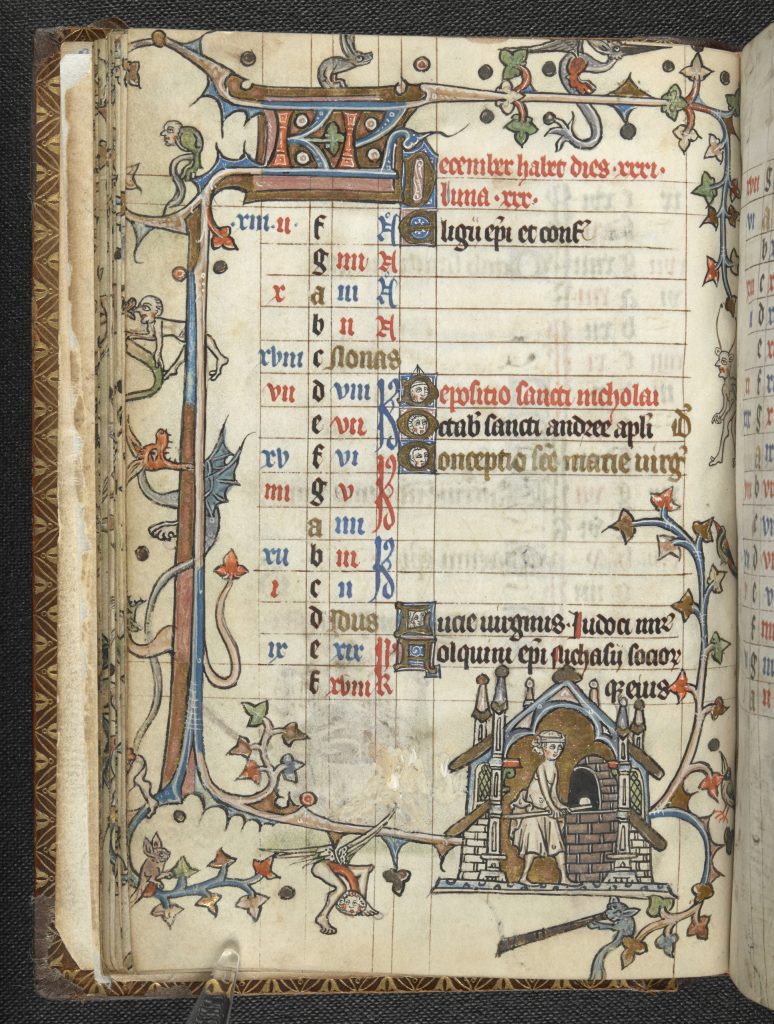
Fig. 24. Hours of St. Omer. London BL Add. 36684. France, St. Omer, 1320-1329, fol. 12v.
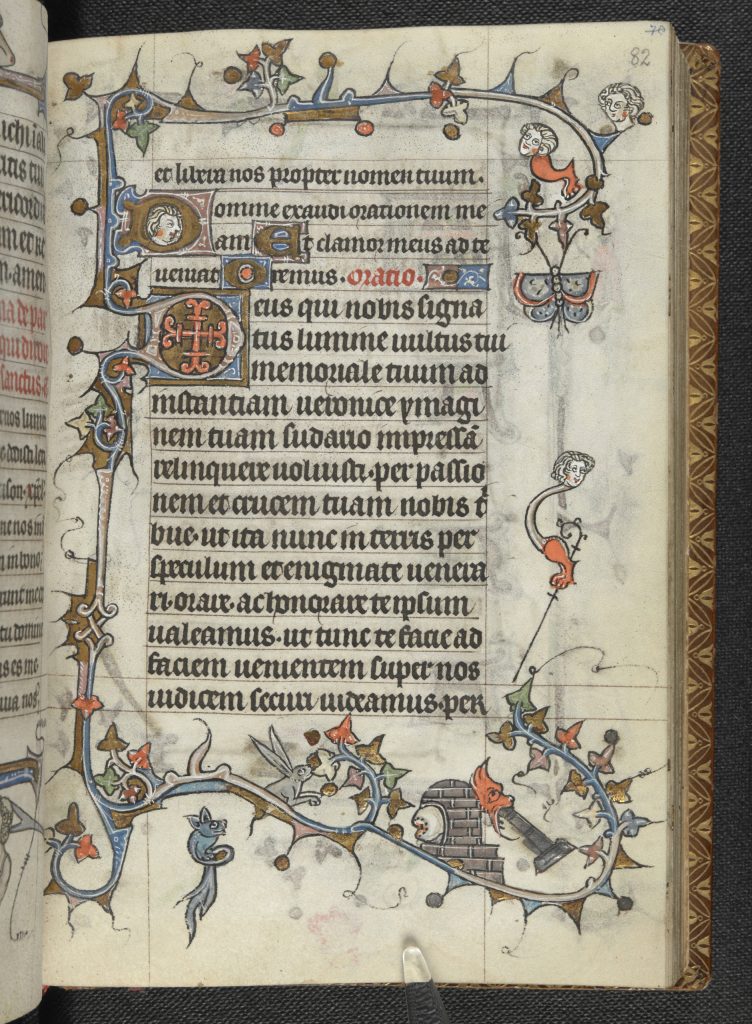
Fig. 25. Hours of St. Omer, France, St. Omer, 1320-1329. London BL Add. 36684, fol. 82r.
In both London BL Add. 36684 (Fig. 25) and in NY PML M. 754 fol. 3v, we see the motif of the ‘bum in the oven’ for the first time.[95] This makes the theme of the oven as a sexual orifice particularly clear. In case there was any doubt about the strange marginal image in London BL Add. 36684 (fol. 82r) with a white body part with a red and black orifice, the allusion is unmistakable in NY PML M. 754 fol. 3v (Fig. 26). Here a man, who seems to be naked except for the typical white coif, kneels inside the oven so his head protrudes on one side, and his bum on the other, with a similar red and black orifice, his feet dangling down the front of the oven.
In NY PML M. 754 fol. 48v (Fig. 27), we also have our first encounter with an animal baker, a monkey, and all the sexual themes merge. In the lower margin, a monkey with an exposed bum (and no baker’s clothing or coif), uses his “baker’s peel” simply to shove it into the oven, in whose opening is clearly a bum with a red and black orifice. Black waving lines emanate from this encounter, perhaps signifying heat. Continuing the baking theme, a monkey on the right-hand margin holds a tray with four white, round miches upon it, and points his finger (in a reprimanding gesture?) towards the monkey inserting the peel into the ‘oven bum.’
Fifteenth- and Sixteenth-Century Collaborations and a Return to the Fournier
Although the sexual element is not always as forcefully present, the trope of animal bakers in the margins continues into the fifteenth century. In the Pontifical now in London from the first half of the fifteenth century (Lansdowne MS 451 fol. 6r; Fig. 28), we see a rabbit baker standing upright on grass (with flowers on either side of it, and even extending from its head), in profile, in the unmistakable gesture of the fournier. It is difficult to make out the shape of the bread—it is not round in the typical shape of the miches. The oven itself is hovering in air, and there is no indication of flames or any sort of indoor context.
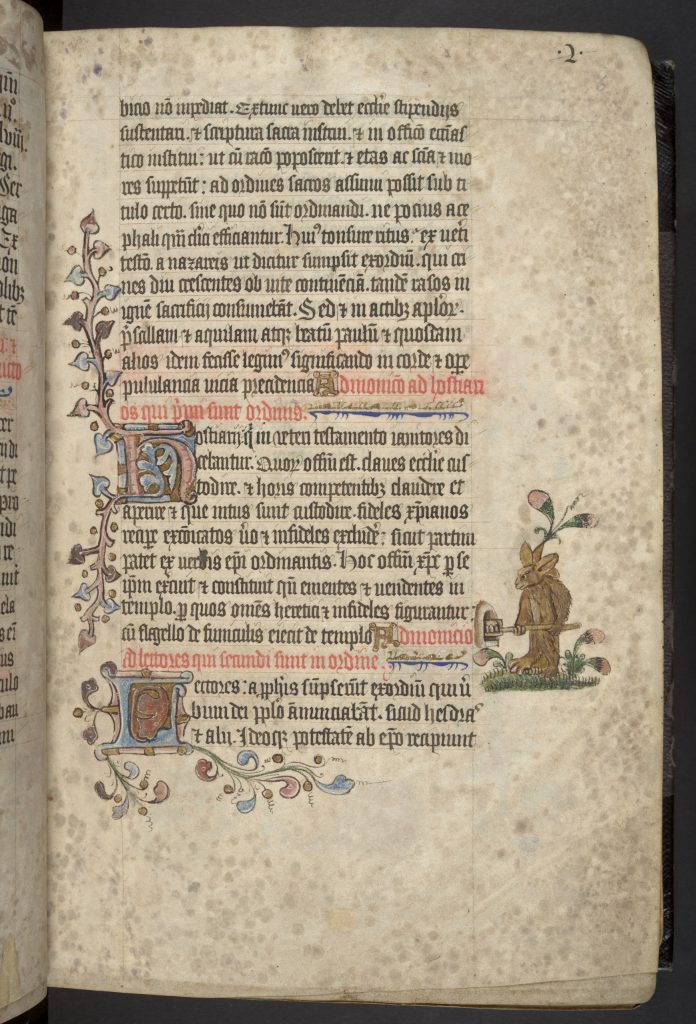
Fig. 28. Pontifical, London, BL Lansdowne MS 451, fol. 6r, first half of 15th century.
But the fifteenth century gives us some of our most detailed examples of the frequent indoor conditions of baking, as well as providing more and more visual material about collaborative work, and outlining more steps in the baking process. While most of these manuscripts are still religious, there are important representations in secular manuscripts as well. For example, in the Tacuinum Sanitatis[96] from Germany (Cologne) 1474, now in Paris BnF lat. 9333, on fol. 61r (Fig. 29), we see a man and a woman collaborating indoors. The young man takes on the role of the fournier, probably in this case removing two round miches from the oven. There is a table in front on which two round bread loaves sit, and a basket to the left overflowing with miches. His female co-worker holds the basket with one hand and gestures to him with her other, perhaps indicating that she has no more room for bread in her basket (?). There is no indication of flames or the heat of the oven, and both workers are fully clothed.

Fig. 29. Tacuinum Sanitatis, Paris BnF lat. 9333, fol. 61r. Germany (Cologne?), 1474.
On folio 62v of the same Tacuinum Sanitatis manuscript (Paris BnF lat. 9333; Fig. 30), we see male and female co-workers collaborating again. This time the oven (with an unusual triangular top on the opening) is empty of both bread and flames. The table in the foreground displays a cluster of miches, and one of the tables in the background features a basket containing a single miche. A woman in the center is placing miches one by one into a cloth held by a figure, who will presumably take charge of the distribution. We will return to this manuscript when we turn to all-female workplaces.

Fig. 30. Tacuinum Sanitatis, Paris BnF lat. 9333, fol. 62v. Germany (Cologne?), 1474.
On fol. 10v of the Egmont Breviary, from the Netherlands from ca. 1440 (Fig. 31), we have a fully painted rectangular marginal scene of a male and female coworker baking in an interior space. It is a well-to-do interior with lattice windows, a grisaille stained-glass window featuring a portrait of an older man, and tiled floors. The table in the right foreground displays six small loaves. The oven is on the right, and the man, wearing a black cap, places two white miches from his peel into the oven. His female collaborator is depicted on the left wearing a red dress and two buns in her hair (but no hat), kneading the dough into balls. There is one large ball of dough in front of her, along with two smaller ones. Presumably the darker color indicates which loaves have been baked, and the lighter color suggests which ones have not. Both figures seem intent on their tasks, and there is no apparent interaction between them, even though they are side-by-side. For another image of a woman kneading dough into balls, we can see the Virgil Master’s ‘Noli me tangere and Martha preparing food,’ in St. Augustine, City of God, trans. Raoul de Presles, The Hague, Koninklijke Bibliotheek, Ms. MMW 10 A 12, illuminated in Paris ca. 1410-1412, fol. 191r (Fig. 32). Here there is an oven in the background, two balls of dough already formed on the table, and Martha, wearing an apron and a white cloth head covering, is shaping two balls of dough simultaneously.[97] Kneading (pétrissage) requires a lot of force. When larger amounts of dough are involved, it was often done in a sizeable trough (pétrin).[98]
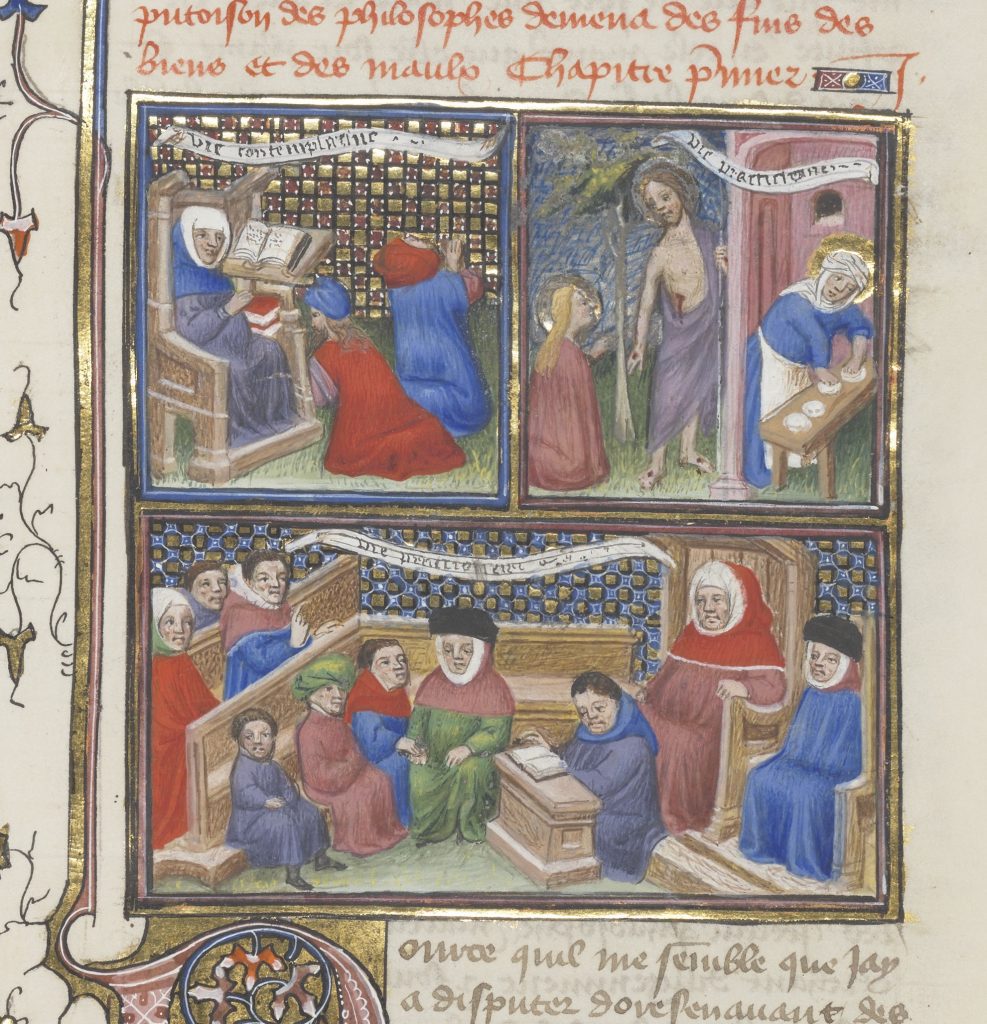
Fig. 32. Virgil Master, ‘Noli me tangere and Martha preparing food,’ in St. Augustine, City of God, trans. Raoul de Presles, The Hague, Koninklijke Bibliotheek, Ms. MMW 10 A 12, ca. 1410-1412, fol. 191r.

Fig. 33. Book of Hours of Charles d’Angoulême, Paris BnF lat. 1173, fol. 6v, Anboumois, ca. 1490, by Robinet Testard.
Returning to Books of Hours and to France, we have the Hours of Charles d’Angoulême, from ca. 1490 from Anboumois, by the artist Robinet Testard (Fig. 33),[99] and a much more suggestive relationship between two workers. Here again we clearly have an indoor context, although we have a cropped view without any details about the wealth of the setting. A woman is observing the baking scene from a window on the far right. In the middle in the background, there is a table full of relatively flat miches. In the foreground, a man holds an enormous baker’s peel completely horizontally, at the level of the genitals, with a single miche upon it. His female coworker seems to be removing a miche from the peel (although she seems oblivious to the heat). The two coworkers seem to be glancing more at each other than focusing on the task at hand. Fully clothed – the woman with a prominent apron wrapped around her waist –, neither one of them seems to pay much attention to the heat, even though the fire in the oven is one of the most elaborate ones we have seen so far, with lighted sticks, grey ashes and reddish-orange flames spilling out of the oven cavity. With the loving glances of the couple — who are inclining towards each other –, the erect position of the peel and the warmth spilling out of the oven, we see that the sexual implications of baking are not an isolated incident.
One of the most detailed collaboration scenes, this time devoid of any obvious amorous workplace implications, is from the Franciscan Missal now in (and probably originally from) Lyon, BM Ms. 514, fol. 6r from ca. 1490 (Fig. 34).[100] We have our most detailed indoor setting here, and it seems likely that this is a rare depiction of an actual bakery, or at least an intentional representation of a recognizable work space, since the open doors show a densely-populated urban context. The room features a wooden ceiling, lattice windows, and a tiled floor, but the interior decoration seems to be more utilitarian than aesthetic, with wood beams supporting buckets and heavy cloths that are essential to the process of bread-baking. On the left, we see a worker kneading dough in a deep trough (pétrin); his back is bent[101] with the effort of pressing and manipulating the dough. On the right, we have the typical fournier with a large horizontal peel placing three white miches into the oven. It is a two-story oven, and its upper story is blackened from constant use. Everyone is fully clothed, and no one seems to be reacting at all to the heat. From the door on the back left, a man enters with a long, huge tray full of miches balanced horizontally on his head with the help of his right hand. A table in the background is full of white miches ready to be baked. In addition to the three men, there is one woman towards the back right whose role is the most ambiguous: she stands, statue-like, in between the table full of miches and the oven, holding a single miche in her hands. Presumably, she is the one who transfers the miches to or from the fournier. This is the most collaborative scene we have seen so far, giving us a glimpse of the complexity of work, and the division of labor, that goes into large-scale bread production for an urban population.

Fig. 34. Lyon, BM MS. 514, fol. 6v, Franciscan Missal, ca. 1490.
There are also a few examples from the late fifteenth and early sixteenth centuries of depictions of ‘women only’ bakeries. Although we have seen men and women collaborating from our earliest Psalters, it is an important observation that women are sometimes also depicted working together without men.[102] Women played a particularly prominent role in the textile and food industries, and for baking in particular, notaries exceptionally used the feminine form of the word baker in contracts (pistorissa, pistorix, or pistrix).[103] There are several documents confirming that girls were apprenticed to work for widows.[104] Both textual and visual evidence seem to indicate that women bakeries were not unheard of at this time. Returning to the imagery, in the Tacuinum Sanitatis (Paris BnF lat. 9333), from Germany (Cologne?) from 1474, there is one folio in the bread-making sequence that shows only women (fol. 61v; Fig. 35). This is the only example we have seen so far of a female fournière. The oven, again with an unusual cusped opening (that we saw elsewhere in the manuscript and that could have vaginal implications[105]), supports a group of sticks on top; we see a black interior and no indication of flames. The three women are wearing robes, and the fournière, dressed in a purple robe, wears a cloth head-covering as well. She is placing two round miches into the oven. The middle woman, in a blue robe, holds the end of the peel to help her coworker, and lifts her arm up, gesturing towards the oven. The third woman, on the right, holds a ball of dough in her hands, presumably preparing for the next round of baking. There are a total of five tables with balls of dough ready to be baked, and in the back right, there is a table with a basket filled with baked loaves. We can clearly see the difference in color between the raw dough and the fully-baked bread. This is among the most cooperative, harmonious collaboration scenes we have seen.

Fig. 35. Tacuinum Sanitatis, Paris BnF lat. 9333, fol. 61v. Germany (Cologne?), 1474.
There is another ‘all-woman’ bakery in a Book of Hours from Bruges-Flanders (Fig. 36. NY: PML M. 1175, fol. 15r, 1525-30), although this one seems to be much less idealized than the one we just saw in the Tacuinum Sanitatis, and might come closer to depicting actual working conditions: the “tough, sweaty work of the kitchen.”[106] Since this manuscript is badly damaged, it is difficult to determine whether this is another bakery in an urban context, or a depiction of private cooks in a room of a château or a manor. This bakery is a rare glimpse of the dangerous heat and the difficult task of large-scale bread production. The female worker on the right holds a round tray with three miches. Yet unlike the man in the Lyon Missal who effortlessly balanced a huge tray on his head, this woman leans backwards, clearly demonstrating the weight and fatigue that this repeated task could produce. The woman on the left is the fournière, but rather than being shown placing bread in (or removing it from) the oven, she balances her peel on the ground. The oven gives one of our most detailed depictions of logs on fire, this time with the most illusionistic combination of yellow and orange paint and wisps of smoke. The woman’s back is hunched over, and her arm raised upwards suggests her trying to shield herself from the high temperatures. Although some men starting in the thirteenth-century Psalters we examined went bare-chested, we have not yet seen a single female worker in anything less than heavy robes. These two women also wear layers of clothing as well as aprons. This may be one of the rare glimpses into the difficulties of the profession, particularly for women (who were unlikely to have removed much of their clothing while working, in spite of the heat of the furnace).
Yet in the fifteenth century, it is surprising how much of the thirteenth-century tradition of single, male fourniers persisted. Aside from the exceptions just discussed above, we still have a predominance of decontextualized solo male bakers. For example, there is a Book of Hours from Lyon from ca. 1450-60 (Princeton MS Garrett 54, fol. 13r;[107] Fig. 37) that shows the fournier fully dressed with a black cap placing a round, white miche at an odd angle into the oven that has a triangular top like a house. Again illustrating the labor for the month of December, this is a small, round marginal image tucked into a floral side bar. Against a gold background, there is no context provided about the workspace.

Fig. 37. Book of Hours, Princeton MS Garrett 54, fol. 13r, Lyon, 1450-60.
In a Book of Hours from Paris (Fig. 38. Book of Hours, NY PML MS M. 815, fol. 12r, Paris, 1471-85.),[108] the lower marginal scene, in rectangular format, shows a fully dressed fournier this time probably removing the already baked loaf from the round, vaulted oven. He is wearing a golden cap and an apron. Other than the apron and his bent back, there are few details about the work itself: no fire is visible, he does not seem to be expending much of an effort, and there are no collaborators. He is clearly in an interior space, but it is unclear whether or not it is part of a bakery.
We have slightly more information about the work taking place in a Book of Hours from Burgundy, possibly from Autun, now in New York, NYPL MS Spencer 43, fol. 17r, dated to 1480-90.[109] In the lower margin illustrating the month of December, we see a fournier with his peel fully inserted into the oven, from which red and orange flames swell. There are three round loaves waiting to be baked on the table in the foreground. The worker is clearly indoors, and there is a window to the left, but it is uncertain whether it is a bakery or the interior of someone’s home. The only indication of ‘work clothes’ is his apron, and he’s not even wearing a hat.
In NY PML MS M. 7, fol. 4r, from Paris from 1490-1500 (Fig. 39) at the top of the calendar page for November and December, we have the two most common labors illustrated, along with the signs of the zodiac. On the left (November) we have the fournier, who appears to be outdoors, at a type of four banal in an urban context, next to the zodiac symbol of Sagittarius. On the right (December), a similar-looking man is shown killing a boar next to the symbol of Capricorn. The oven is dark inside with only a few wispy hints of flames, and two small, round, cooked loaves sit on a table in the foreground that forms part of the oven. Interestingly, both culinary workers resemble artists: in the baking scene, the thinness of the peel inside the oven brings to mind a long paint brush, and the rounded knife approaching the boar is held in a surprisingly non-violent gesture, that seems to be almost gentle—the man could almost be using a pen knife as part of the process of manuscript illumination.
In another Book of Hours, several marginal scenes illustrate the month of December (Fig. 40. Book of Hours, NY PML MS H. 5 fol. 6v, Paris, ca. 1500). In the lower margin, we have the Nativity, the baker, and the goat as the symbol for Capricorn. The baker is again a lone male fournier. He’s in an interior setting, and given the quantity of bread within the space, it is likely to be an actual bakery. There is a table full of white round miches in the back left, and the man, dressed in an all-white tunic and a red cap, places one round miche with his peel into the vaulted, two-storied oven. There is a tiny indication of orange color in the oven, but very little suggestion of heat or hard work.
Coda
The rich and varied picture we find of bakers in medieval art can be supplemented with two examples from a long tradition of “worker’s poems” in French literature. There is a poem called the Dit du Boulanger, that was written probably in the first half of the thirteenth century, and is conserved in only two manuscripts, Paris BnF fr. 837 fols. 175-175v (110 lines) and Bern, Stadt und Universitätbibliothek 354, fol. 75v-77 (126 lines).[110] However, the instruments used and the different phases of baking are not described, and neither is the oven or the pétrin for kneading. There are much more evocative descriptions of baking in the eighteenth century.[111] An unusually vivid worker’s poem survives from 1739, called the Misère des garçons boulangers, that describes in great detail the back-breaking working conditions of being a baker in eighteenth-century Paris. Here are some particularly expressive excerpts:
Lecteur, écoutes un peu, rumine et considère/ Les plaintes que je fais de ma propre misère ;/ Je vais, par ce discours, te faire envisager/ Les maux qu’il faut souffrir quand on est Boulanger/ Campé dessus mon Four avec un ratissoire/ J’endure autant de mal que dans un Purgatoire . . . La nuit, temps de repos, est pour nous la torture/ La Lune & le Soleil pour nous tournons sans fruit, / . . . Passer toutes les nuits dans la captivité.[112]
[Reader, listen a little, ruminate and consider/ The complaints that I make of my own misery/ I will, with this discourse, help you to imagine/ the terrible things you must suffer when you are a baker./ Camped below my oven with a scraper/ I endure as much evil as in Purgatory . . . at night, the time for rest, is torture for us/ For us, the moon and the sun turn for no purpose/ We pass all our nights in captivity]
The narrator goes into more details about why it is such a difficult life:
Faut malgré tout cela travailler à la hâte/ Tourner & retourner la farine & la Pâte/ Après en mille & mille morceaux à diviser/ Puis à différens poids mille fois la peser . . . Je me sens consummer jusqu’au centre de l’ame/ Vêtu comme un faquin, sans chemise & tout nu/ Je n’ai qu’un geunillon [sic] qui me couvre le cu.[113]
[In spite of everything, we have to work in haste/ Turning and turning the flour and the dough/ Afterwards, thousands and thousands of pieces to divide/ The different weights to weigh a thousand times . . . I feel consumed to the center of my soul/ Dressed like a rascal, without a shirt and completely nude/ I only have a small, tattered rag to cover my ass]
He laments: ‘Quoi? Toujours travailler, toujours dans la douleur/ Sans gouter ni jouir d’un moment de bonheur:/ Entre tous les métiers j’ai bien choisi le pire’ [What ? Always working, always in pain/ Without tasting joy or a moment of happiness:/ With all of the métiers available, I definitely chose the worst one].[114] And apparently he perceived that the conditions in Paris were particularly bad, compared to the surrounding towns: ‘Mais au moins si j’étais Boulanger à Gonesse/ A Linas, Ville-Juif, j’aurois l’allégresse/ Car tous les Boulangers , & ceux de Saint-Denis/ Ne sont point malheureux comme on est à Paris’ [But at least if I were a baker at Gonesse/ At Linas, Villejuif, I’d have some relief/ Because all the bakers, and those from Saint-Denis/ Are not as miserable as we are in Paris].[115]
Bread production was a fraught issue throughout the Middle Ages and beyond. Although the calendar scenes in illuminated manuscripts, where the standard images of bakers seems to have crystalized, almost always seem to have an air of serenity, the period during which they were produced was the opposite: it witnessed a Peasants’ Revolt in England in 1381, many plagues (especially in the fourteenth century), and concurrent severe labor shortages.[116] A bad season of crops could spell famine.[117] There were grain shortages in 1305 and 1309, and the so-called ‘Great Famine’ lasted from 1315-1322, reaching its height in 1316, when the prices of wheat, barley and oats shot upwards.[118] The Great Famine of 1315-1322 was followed by other famines 1328, 1334, and 1340-1.[119] And conflicts between bakers and authorities were rampant.[120] Bakers staged revolts in Lyon in 1255, in Strasbourg in 1301, and at Chalon-sur-Saône in 1508.[121] The question about fixing the fair price of bread remained a central problem of the French Revolution, and even as late as the nineteenth and twentieth centuries bakers constantly engaged in disputes about bread pricing with the municipalities.[122]
Baking is complex, collaborative, communal, tied to the rural land through grain production, and entrenched in cities through abundant and highly visible and regulated bakeries. Today, bread consumption constitutes a much lower proportion of the diet than it did in the Middle Ages. Nevertheless, with small-scale stores threatened by the competition of massive supermarkets on the outskirts of town, bakeries are still the last shops to shutter in the centers of small French villages;[123] access to freshly baked bread is still therefore considered to be a priority. Although images of bakers from medieval France appear in multiple contexts, the lone male fournier became the most stable iconography through illuminated manuscripts, and continues to this day to feature prominently on bakery shop signs. The persisting predominance of this image masks the complexity of collaboration, and belies the important contributions of women in bread production. Why has this iconography had such a long history? The image of the fournier provides a certain level of stability, which rarely corresponded to reality, especially during the fourteenth century. Another element that probably led to the endurance of this image may be its sexual implications: as we saw, the warm oven often represents a womb, or simply an orifice, and the baker’s peel a phallus. Furthermore, in modern French, the name for the typical round bread, une miche, when used in plural, les miches, is slang for breasts.[124] Although this one iconographic theme wound up becoming dominant, we should remember that the actual work of baking is much more physically taxing and multifaceted: the collaborative, yet dangerous, labor that men and women bakers performed for centuries in order to put bread on everyone’s tables. As the anonymous poet in the Dit du Boulangers put it in the thirteenth century, bakers “soustient le monde” (support the world)![125]
References
| ↑1 | I am grateful to the Gerda Henkel Foundation for providing a summer fellowship that enabled me to conduct part of the research for this paper at the Zentralinstitut für Kunstgeschichte in Munich. I thank Diane Wolfthal and the editors of this journal for their support and encouragement, and the anonymous reviewers for their extremely careful readings and helpful critiques.
All Biblical citations in this paper are from the Latin Vulgate. For a recent edition, see The Vulgate Bible: Douay-Rheims translation, Edgar Swift and Angela M. Kinney, eds. (Cambridge, MA: Harvard University Press, 2000-2013). |
|---|---|
| ↑2 | Gervase Rosser, “Crafts, Guilds and the Negotiation of Work in the Medieval Town,” Past & Present 154 (Feb. 1997): 3-31, at 3. For some similar conclusions about the Renaissance: “[I]n current research . . . lower classes are often treated as makers or classified collectively as workers, without a proper investigation and understanding of their potentially diverse experiences of culture.” See Paula Hohti Erichsen, Artisans, Objects, and Everyday Life in Renaissance Italy: The Material Culture of the Middling Class (Amsterdam: Amsterdam University Press, 2020), 30. Her book considers what she calls “lower social groups” – shoemakers, barbers, bakers, innkeepers, tailors (31). |
| ↑3 | Jan Theo Bakker, ed. The mills-bakeries of Ostia: description and interpretation (Amsterdam: J.C. Gieben, 1999), 11. For bakers in Ostia Antica, just outside of Rome, see Bakker (1999) who studied 3 bakeries in Ostia: Caseggiato dei Monini, Molino I,XIII,4, Caseggiato delle Fornaci (4). Also see: https://www.ostia-antica.org/dict/topics/bakeries/bakart.htm. Accessed 9 September 2021. https://doi.org/10.1163/9789004525825 |
| ↑4 | In fact, the English title Lord derives from the Anglo-Saxon for ‘loaf-guardian’ (hlafweard) and the word Lady from ‘loaf-kneader’ (hloefdige). See Carolyn Coulter, “Of Cakes and Kings: bread-making in early medieval England,” in Bread for the People: the archaeology of mills and milling, Proceedings of a colloquium held in the British School at Rome 4th-7th November 2009, ed. David Williams and David Peacock (Oxford: Archaeopress/Hadrian Books Ltd, 2011), 179-192 at 179. |
| ↑5 | Jane Welch Williams, Bread, Wine & Money: the windows of the trades at Chartres Cathedral (Chicago: University of Chicago Press, 1993), 39; Patricia Basing, Trades and Crafts in Medieval Manuscripts. (London, 1990), 91; Jean-Michel Lecat, La grande histoire du pain et des boulangers des origines à nos jours (Paris, Lodi, 2006), 51: in the 14th century, French people ate at least 1kg of bread per day! Perrin Mane, Calendriers et techniques agricoles, France-Italie, XII-XIII s. (Paris: Le Sycomore, 1983). She notes that in medieval western Europe, “la campagne est tout” (the countryside is everything) (9). Cereals and grains were the big preoccupation of peasants in the Middle Ages. Bread was the basis of alimentation (141). See Sophie Cassagnes-Brouquet, Les métiers au Moyen Âge (Rennes, Éditions Ouest France, 2010), 48. This tremendous dependence on bread continued least through the 18th century. See Steven L. Kaplan, The Bakers of Paris and the Bread Question, 1700-1775 (Durham: Duke University Press, 1996), 1. |
| ↑6 | Lecat, 29, 51; Jacques Devalette et al., La peste de feu, Les cahiers d’ARCHEA, no. 3 (Limoges: L’archéothèque, 1994), 69, Jean-Louis Massimo Montanari Flandrin (dir.), Histoire de l’alimentation (Paris: Fayard, 1996), 480 (the lower the income, the higher proportion of bread was in their diet); Danièle Alexandre-Bidon, La cuisine au Moyen âge (Paris: Tour Jean Sans Peur, 2009), 25. |
| ↑7 | Williams 1993, 39. Further health problems were caused by medieval custom of adding different fillers: mashed or powdered beans, clay or even sawdust to stretch the use of the precious grains. The lower the economic status of the individual, the more likely s/he was to eat bread from badly stored or fouled grain (39). Lecat (45) – the mal des ardents is estimated to have killed 40,000 people per year. It caused convulsions, spams, vomiting, burning, and freezing sensations in the limbs, and craziness. Devalette, 26-27. Also see Mary Metossian, Poisons of the Past: Molds, Epidemics, and History (New Haven: Yale University Press, 1989). |
| ↑8 | Willy Jansen, “French Bread and Algerian Wine: Conflicting Identities in French Algeria,” in Food, Drink and Identity: Cooking, eating and drinking in Europe since the Middle Ages, ed. Peter Scholliers (Oxford: Berg, 2001), 195-218, at 202. The comparison between French and Arab bread was apparently a big issue during the colonization of Algeria (Jansen, 203). https://doi.org/10.5040/9781350044845-ch-011 |
| ↑9 | Lecat, 29, Alexandre-Bidon 2009, 25. The term ‘boulanger’ actually comes from ‘boule,’ since most breads at this time had a round form. Philippe Ménard, “Le Dit des Boulangers,” in “Lis premerains vers”: Essays in Honor of Keith Busby, ed. Catherine M. Jones and Logan E. Whalen (Rodopi: Amsterdam, 2011), 261-280, at 268. Round bread takes up less space, loses less flour, and importantly, conserves much better (Ménard, 269). |
| ↑10 | The baguette is “so intimately identified with France that it is practically a metonym for the nation and its civilization.” (Kaplan, 4). In November 2022, the baguette was granted World Heritage Status by UNESCO. See Catherine Porter and Constant Méheut. “A Slice of France, the Baguette Is Granted World Heritage Status,” The New York Times, 30 November 2022. |
| ↑11 | Bakker, 11, 13. |
| ↑12 | Lecat, 31. |
| ↑13 | It was actually forbidden for a baker to also produce pastries; this rule applied to the bakers of Paris under the Grand Panetier de France, a royal official who was charged with applying the statutes starting in 1305 (see below). Cassagnes-Brouquet, 48. |
| ↑14 | Lecat, 28, 29 and Bakker, 6. |
| ↑15 | Bakker, 11. |
| ↑16 | Bakker, 4, 15. Watermills are much more efficient than mills pulled by animals: they could grind 150kg per hour. Also see Du grain à la farine: exposition présentée au Musée Archéologique de Dijon, 13 décembre 1982-28 février 1983, ed. Micheline Jeanlin (Dijon: Musée Archéologique, exposition, 1982), 49. Watermills are described by Vitruvius in his Treatise on Architecture; see Lecat, 57. |
| ↑17 | Bakker, 7. He came to this conclusion because of the continuous presence of smoke, heat and flour dust, the need to operate heavy machinery, and the overall discomfort of their working spaces. |
| ↑18 | See Lecat, 27. |
| ↑19 | Lecat, 29. |
| ↑20 | Bridget Ann Henisch, “In Due Season: Farm Work in the Medieval Calendar Tradition,” in Agriculture in the Middle Ages: Technology, Practice, and Representation (Philadelphia: University of Pennsylvania Press, 2016), 309-336; also see Jane Welch Williams, “The New Image of Peasants in Thirteenth-Century French Stained Glass,” Agriculture in the Middle Ages, 277-308, at 286. |
| ↑21 | Williams 1993, 62. https://doi.org/10.1016/0022-5428(93)90054-S |
| ↑22 | Williams 1993, 54. https://doi.org/10.2307/3711801 |
| ↑23 | Kaplan, 3. |
| ↑24 | Caroline Walker Bynum, Holy Feast and Holy Fast: the religious significance of food to medieval women (Berkeley: University of California Press, 1987), 48, 56. https://doi.org/10.1215/00267929-48-3-281 |
| ↑25 | Williams 1993, 55. See below for a link to Pierre de Celle’s text in Latin. |
| ↑26 | One notable exception is Genesis 40: as part of the story of Joseph, he interprets the dreams of the Pharaoh’s baker and butler, whom he met in prison. The butler winds up being released, but the baker is hanged. This iconographic theme will not be considered here because although we know the baker’s profession, since Joseph meets him in prison, he is not performing his usual occupation, and he is thus never depicted at work. |
| ↑27 | They were ‘rediscovered’ in Europe in the 10th c. Lecat, 57, 65. |
| ↑28 | Lecat, 65; Jean-Yves Dufour, “La fouille du moulin à vent de Roissy-en-France (Val-d’Oise), France,” in Bread for the People: the archaeology of mills and milling. Proceedings of a colloquium held in the British School at Rome 4th-7th November 2009, ed. David Williams and David Peacock (Oxford: Archaeopress/Hadrian Books Ltd, 2011), 249-258, at 249; Basing, 40. They only started to be destroyed in the middle of the nineteenth century (Dufour, 257). |
| ↑29 | Alfred Carlier, Histoire des boulangers (Cannes: Aegitna (Bibliothèque de travail 63), 1949), 1-2. There were, needless to say, ‘fours clandestins,’ that were relatively easy to hide (Lecat, 65). |
| ↑30 | Carlier, 2. |
| ↑31 | Françoise Desportes, Le pain au moyen âge (Paris: Orban, 1987), 43, 44; Cassagnes-Brouquet, 48. My references to “peasants” in this paper generally refer to agricultural laborers. The production of bread was a complex situation whose workers varied depending on geographical location (rural vs. urban), but bread production in any situation depends entirely upon the harvesting of grains. |
| ↑32 | In French the term for a sieve is tamise, and depending on the device, it could produce fine or coarse flour. Ménard, 268. |
| ↑33 | Kaplan, 81; Ménard, 270. |
| ↑34 | Flandrin, 435. |
| ↑35 | Lecat, 68. |
| ↑36 | Appointed by King Louis IX, Etienne Boileau held the office of the royal provost of Paris from 1261-1270. See Sharon Farmer, The Silk Industries of Medieval Paris: Artisanal Migration, Technological Innovation, and Gendered Experience (Philadelphia: University of Pennsylvania Press), 2017, 7. The Provost exercised fundamental jurisdiction of the guilds, and had the final word about enforcing their rules (Farmer 2017, 120). |
| ↑37 | Desportes, 148. The Livre des métiers governed the guild for the next 4.5 centuries (Kaplan, 155). |
| ↑38 | Kaplan, 155. |
| ↑39 | Kaplan, 168. Ménard, 266. |
| ↑40 | Kaplan, 168-9. |
| ↑41 | Elizabeth Sears, “Craft Ethics and the Critical Eye in Medieval Paris,” Gesta 45, 2 (2006): 221-238, at 223. The earliest surviving MS, known as the Sorbonne MS, is now in Paris BnF fr. 24069 (begun probably in the early fourteenth century, added to progressively throughout the century), and the two other surviving manuscripts are the Lamare MS (Paris, BnF fr. 11709), and the Châtelet MS (Paris, AN KK 1336), are both also from fourteenth century. Caroline Bourlet, “Le ‘Livre des métiers’ dit d’Etienne Boileau et la lente mise en place d’une législation écrite du travail à Paris,” Médiévales 69 (automne 2015), 19-48, at 32-33. All three surviving manuscripts were presumably composed at the Châtelet of Paris, with the rules written up to 1328 (Bourlet, 47). Unfortunately, the Livre des métiers does not contain any images of bakers. There are marginal drawings throughout BnF fr. 24069 that have been studied by Elizabeth Sears, but they are dispersed unsystematically throughout the MS (Elizabeth Sears, “Scribal Wit in a Manuscript from the Châtelet: Images in the Margins of Boileau’s Livre des métiers, BnF, MS fr. 24069,” in Tributes to Lucy Freeman Sandler: Studies in Illuminated Manuscripts, eds. Kathryn A. Smith and Carol H. Krinsky (London: Harvey Miller, 2007), 157-172, at 157, and no bakers are drawn in. The manuscript can be viewed in its entirety here: https://gallica.bnf.fr/ark:/12148/btv1b10509418n (accessed 1 Sept. 2021). |
| ↑42 | Lecat, 73. During the time of Philippe-Auguste, the prévôt de Paris wanted to remove ovens from the center of the city, but the bakers succeeded in removing this measure. (Ménard, 267. |
| ↑43 | The typical hierarchy consisted of apprentices-compagnons- maîtres (Bronislaw Geremek, Le salariat dans l’artisanat parisien aux XIIIe-XVe siècles: étude sur le marché de la main-d’œuvre en Moyen-âge. trad. du polonais par Anna Posner et Christiane Klapish-Zuber (Paris: EHESS, 1982), 28). |
| ↑44 | This includes different types/qualities of bread to be produced. Patrick Rambourg, “Pratiques alimentaires, savoir-faire et professionnalisme dans les métiers de bouche parisiens (fin du Moyen Âge et Renaissance).” Médiévales 69 (automne 2015): 87-104. “Les premiers statuts des boulangers (talemeliers), ceux du Livre des métiers, distinguent trois sortes de pains: le pain dit demie d’une obole, ‘le pain d’un denier (la denrée)’ et le pain de deux deniers ou doubleau” (Rambourg, 94). https://doi.org/10.4000/medievales.7601 |
| ↑45 | Sears 2007, 158. For one example, Boileau reprint 1980, 9, article XXX: ‘Li Talemelier puent cuire les lundis ains jour si tost come matines de Nostre Dame sonent, se aucunes de festes dessus dites n’i escheent.’ |
| ↑46 | Alfred Franklin, Dictionnaire historique des arts, métiers et professions (Paris: H. Welter, 1906), 95. |
| ↑47 | Sears 2006, 229. |
| ↑48 | Franklin, 36. Markus Späth, “The Body and its Parts: Iconographical metaphors of corporate identity in thirteenth-century common seals,” in Pourquoi les sceaux ? La sigillographie, nouvel enjeu de l’histoire de l’art. Eds. Marc Gil and Jean-Luc Chassel (Lille: Institut de Recherches Historiques du Septentrion, 2011), 383-400, at 383, 396. https://doi.org/10.4000/books.irhis.2909 |
| ↑49 | Franklin, 36. |
| ↑50 | Notre pain quotidien: Strasbourg, exposition au Musée alsacien, 14 décembre-29 février 1976, ed. Georges Klein (Strasbourg: Musée alsacien, 1975), 19 and 20. Pretzels also featured prominently on bakers’ seals from Switzerland; see Virginia Raguin’s contribution to this volume. As late as the eighteenth century, a German tankard also bears a pretzel representing the baker’s guild: https://collection.barnesfoundation.org/objects/5510/Tankard/, accessed on 25 November 2021. I thank Amy Gillette and Kaelin Jewell for bringing this image to my attention. |
| ↑51 | Franklin, 37. |
| ↑52 | Franklin, 37. The bakers’ seal of the Faubourg Saint-Germain is described as follows: “d’azur à un Saint Honoré d’or, tenant de sa main senestre une crosse de même, et de sa main dextre une pelle de four d’argent chargée de trois pains de gueules” (Franklin, 37). For an explanation of the convention of written descriptions of heraldic arms, or blazons, see Michel Pastoureau, Heraldry: an introduction to a noble tradition, trans. Francisca Garvie (London: Thames & Hudson, 1997), chapter 2, 43-73. On the royal edict issued in France that ordered all coats of arms to be recorded in the huge collection of the Armorial général in 1696, see Pastoureau, 33. |
| ↑53 | Brigitte Miriam Bedos-Rezak, When Ego was Imago: Signs of Identity in the Middle Ages (Leiden: Brill, 2011), 28. Also see 155 on the limited repertoire and iconic types. https://doi.org/10.1163/ej.9789004192171.i-322 |
| ↑54 | Edouard Fournier, Paris par ses enseignes (Paris: Editions de la Bibliothèque, 1994), 23-24. Boutiques du temps passé: décors peints des boulangeries, charcuteries et crémeries, Claudine Reinharez et Josselyne Chamarat (Paris: Les Presses de la Connaissance, 1977), 17. |
| ↑55 | Fournier, 30. |
| ↑56 | Reinharez and Chamarat, 17. |
| ↑57 | Olga Koseleff, “Representations of the Months and Zodiacal Signs in Queen Mary’s Psalter,” Gazette des Beaux-Arts (1942): 77-88, at 78. |
| ↑58 | Mane 1983, 13, 16. |
| ↑59 | Mane 1983, 53. |
| ↑60 | James Carson Webster, The Labors of the Month in Antique and Medieval Art to the end of the Twelfth Century (Princeton: Princeton University Press, 1938), 78, 162. For a more recent source on the representations of signs of the zodiac and labors of the month within a case study of twelfth-century monumental sculpture, see Véronique Rouchon-Mouilleron, Vézelay: Livre de pierre (Paris: Flammiron, 1997), 74-87. |
| ↑61 | Williams 1993, 37. |
| ↑62 | Williams 1993, 37. For the Latin, see Pierre de Celle, Opera Omnia, Patrologiae cursus completus, ed. J.P. Migne (Paris, 1885), 929-1047. This source can be viewed electronically at https://gallica.bnf.fr/ark:/12148/bpt6k5493971j/f4.item, accessed 25 August 2022. |
| ↑63 | Williams 1993, 39. See Williams’ sections on “The Importance of Bread at Chartres,” (39) “The Bakers at Chartres” and “The Chapter’s Bakers” (40) for further details. |
| ↑64 | Williams 1993, 38. https://doi.org/10.1177/070674379303800221 |
| ↑65, ↑66 | Williams 1993, 69. https://doi.org/10.1016/S0007-0785(05)80976-7 |
| ↑67 | Williams 1993, 190 n. 253. André Bouton, Le Maine: Histoire économique et sociale des origines au XIVe siècle (Le Mans, 1962), 545, André Mussat et al., La cathédrale du Mans (Paris: Berger-Levrault, 1981), 184. The numbering system I follow here (for window #212) is the one used by Mussat. |
| ↑68 | France and Flanders have the most abundant calendar illustrations. Perrine Mane, Le travail à la campagne au Moyen Age: étude iconographique (Paris (thèse), 2006), 42 ; also see Webster, 78, Henisch, 324. Regarding the dates listed for the manuscripts in the sections that follow, I have privileged the official websites of the libraries and museums that hold the manuscripts, which reflect the current research of the librarians and curators that work most closely with them. |
| ↑69 | See Webster, 5. |
| ↑70 | Webster, 36. A number of calendar scenes survive on ancient Roman mosaics. For an example of a Gallo-Roman floor mosaic from the early third century CE that shows a rustic calendar with people actually working, see the 27 surviving panels from a residence at Saint-Romain-en-Gal now located at the antiquities museum at Saint-Germain-en-Laye. See https://musee-archeologienationale.fr/collection/objet/pavement-de-mosaique, accessed 25 August 2022. |
| ↑71 | Koseleff 1942, 78, the Vienna folio reproduced in Paul Brandt, Schaffende Arbeit und bildende Kunst in Altertum und Mittelalter (Leipzig: Kröner, 1927), 151. Perrin Mane, La vie dans les campagnes au Moyen Age à travers les calendriers (Paris: La Martinière, 2004) 9 ; Webster, 37. Also reproduced and discussed in Margaret Goehring, Space, Place and Ornament: The Function of Landscape in Medieval Manuscript Illumination (Turnhout: Brepols, 2013), 48-50, fig. 19. |
| ↑72 | Lecat 2006, 82: Les talemeliers – ont le droit d’engraisser des porcs en pleine ville, alimentations pour leurs familles, la pratique sera interdite en ville par mesure d’hygiène au XIVe s. Le cochon, revenue annexe du boulanger. |
| ↑73 | Henisch, 309. |
| ↑74 | Henisch, 326. See J.J.G. Alexander, “Labeur and paresse: Ideological Representations of Medieval Peasant Labor,” The Art Bulletin 72, 3 (Sept. 1990): 436-452, at 445 and Michael Camille, “Labouring for the Lord: The Ploughman and the Social Order in the Luttrell Psalter,” Art History 10, 4 (Dec. 1987): 423-454. Peasant labors: winter ploughing, sowing, harrowing, breaking clods, weeding, gathering the next summer’s harvest (Camille, 427). https://doi.org/10.2307/3045750 |
| ↑75 | Mane 1983, 140. https://doi.org/10.1515/9783110241761.140 |
| ↑76 | Roger S. Wieck et al. Time Sanctified: The Book of Hours in Medieval Art and Life (New York: George Braziller, 1988), 50; Basing (1990): 37. The pig was the chief source of meat in the Middle Ages. |
| ↑77 | Camille 1987, Alexander 1990. |
| ↑78 | Alexander 1990. The Calendar cycle presents the ‘natural’ function for peasants, at work (444). https://doi.org/10.1016/0264-8172(90)90020-H |
| ↑79 | Camille 1987, 426 and 432. |
| ↑80 | Alexander 1990, 444 and Camille 1987, 430. |
| ↑81 | Alexander 1990, 445 also see Henisch, 322. Millers had a particularly bad reputation which included laziness and sleeping on the job (Lecat, 68; Flandrin, 436). A French children’s song still popular today is about a sleeping miller who let the mill spin so fast it lost control, which could cause a fire: Meunier, tu dors, ton moulin, ton moulin, va trop vite/ Meunier, tu dors, ton moulin, ton moulin, va trop fort . . .. |
| ↑82 | Mane 2004, “Pourtant le pain domestique, pétri et souvent cuite par le paysan lui-même, reste très répandu jusqu’au XVe s. dans les compagnes” (203). See the forthcoming study by Diane Wolfthal (Yale University Press) on images of household servants. |
| ↑83 | This type of coif was worn by all sorts of working men. For a description, see Françoise Piponnier and Perrine Mane, Dress in the Middle Ages, trans. Caroline Beamish (New Haven: Yale University Press, 1997), 41. |
| ↑84 | On this manuscript, see Mane 2004, 203. |
| ↑85 | Henisch, 326: Women appear more and more frequently in the calendars of the later medieval period, fifteenth and early sixteenth century. Women had always labored side-by-side with men in village farm work. Koseleff (1942): In the twelfth and thirteenth centuries, women are quite often shown doing their share of labor in the harvest, as in actual life (84). For a more recent study that focuses on women workers in southern France, see Kathryn L. Reyerson, Women’s Networks in Medieval France: Gender and Community in Montpellier, 1300-1350 (Basingstoke: Palgrave Macmillan, 2016), esp. Chapter 6: Urban-Rural Connections, 91-110. |
| ↑86 | There is a long history of depicting animals in the margins of medieval manuscripts. For one of the most comprehensive catalogues of marginalia and a major reference source still today, see Lilian M.C. Randall, Images in the Margins of Gothic Manuscripts (Berkeley: University of California Press, 1966). |
| ↑87 | On this MS, see Alixe Bovey, “Didactic Distractions Framing the Law: The Smithfield Decretals (London, BL Royal MS 10.E.iv),” (PhD dissertation, Courtauld Institute, University of London, 2000). |
| ↑88 | See Wieck 1988 cat no 80, fig. 25, and see https://www.thedigitalwalters.org/Data/WaltersManuscripts/html/W88/description.html, accessed on 3 Sept. 2021. |
| ↑89 | I thank Diane Wolfthal for bringing this MS to my attention. |
| ↑90 | Alison Stones, Gothic Manuscripts, 1260-1320 (London: Harvey Miller, 2013-2014), Part I vol. II, cat. no. III-130. NY PML MS M. 754 is catalogued with London BL MS Add. 36684, at 590-594, as Book of Hours, Calendar of Saint-Omer, and Vie de sainte Marguerite in French verse, ca. 1318-20, Saint-Omer or Thérouanne (590). “[A]ll that can be said about the original owner is that she was a lady of Saint-Omer with a particular devotion to the Passion and the Eucharist, and no doubt her name was Marguerite” (593). |
| ↑91 | For a full listing of all of the ovens in this MS, see Randall, 67 and 194. Also see Judith Steinhoff, “Pregnant Pages: Marginalia in a Book of Hours (Pierpont Morgan Library MS M. 754/British Library, MS. Add. 36684),” in Between the Picture and the Word: Manuscript Studies from the Index of Christian Art. Ed. Colum Hourihane (Princeton: Princeton University Press, 2005), 249-61. Twelve of the eighteen ovens Randall found in the margins occur in this MS (observed by Steinhoff, 184). |
| ↑92 | See the reference to Pierre de Celle above. |
| ↑93 | Steinhoff proposes this with regards to the oven the importance of pregnancy for the female owner. Regarding the patron’s probable name, this manuscript contains one of the earliest extensively illustrated versions of Wace’s Life of St. Margaret (181), and see further references to Alison Stones’ book above. Steinhoff also notes that even today that “having something in the oven” refers to pregnancy (184). |
| ↑94 | On a classic interpretation of marginal imagery and artist’s agency, see Meyer Schapiro, “Marginal Images and Drôlerie,” reprinted in Late Antique, Early Christian and Medieaval Art: Selected Papers (New York: George Braziller, 1979): 196-198. For an excellent study of scatological and homoerotic imagery in another manuscript from the Morgan Library, see Domenic Leo, Images, Texts, and Marginalia in a “Vows of the Peacock” Manuscript (New York, Pierpont Morgan Library MS G24), With a Complete Concordance and Catalogue of Peacock Manuscripts, (Leiden: Brill, 2013). For a landmark study on the relationship between marginalia and sexualized images, see the classic study by Madeline H. Caviness, “Patron or Matron? A Capetian Bride and a Vade Mecum for her Marriage Bed,” Speculum 68, 2 (1993): 333-362. |
| ↑95 | On this pun on “bun in the oven,” and in with references to the Hours of St. Omer, see Malcolm Jones, “Marcolf the Trickster in Late Medieval Art and Literature OR the Mystery of the Bum in the Oven,” in Spoken in Jest, ed. Gillian Bennett (Sheffield, UK: Sheffield Academic Press, 1991): 139-174. |
| ↑96 | This text, literally “table of health,” was translated from the Arabic Taqwim al-sihha of Ibn Butlan, which was written in Baghdad from the eleventh century. See Alixe Bovey, Tacuinum Sanitatis. An Early Renaissance Guide to Health. (London: Sam Fogg, 2005), 9, 15. |
| ↑97 | I thank Diane Wolfthal for bringing this image to my attention. For the official website, see https://manuscripts.kb.nl/show/manuscript/10+A+12, accessed on 19 September 2022. |
| ↑98 | Ménard, 269. |
| ↑99 | Mane 2004, 192. |
| ↑100 | Mane 2004, 192, 200: On the image from Lyon: “les différentes étapes de la fabrication du pain : le ‘gindre’ pétrit la pâte, puis le boulanger la débite en boules, ou pâtons; placés sur une table à tréteaux proche du four, les pâtons sont retournés plusieurs fois pour que l’eau commence à s’évaporer; les tissus qui ont servi à les recouvrir sont suspendus à une patère fixée au mur ; les pains sont ensuite enfournés; une fois cuits, ils sont posés sur une planche que le commis tient en équilibre sur sa tête grâce à un coussinet.” |
| ↑101 | The bent back is a sign of labor that continues into the early modern period. See Georges Vigarello, “The Upward Training of the Body from the Age of Chivalry to Courtly civility,” in Fragments for a History of the Human Body, Part II, ed. by Michel Feher (NY: Zone, 1989), 2nd printing 1990, 148-99. I am grateful to Diane Wolfthal for this observation and this reference. |
| ↑102 | Most research on women’s workplaces in the Middle Ages has focused on a monastic context. For example, on textile production, see Fiona Griffiths, “Like the sister of Aaron: medieval religious women as makers and donors of liturgical textiles” in Female vita religiosa between Late Antiquity and the High Middle Ages, ed. Melville and Muller (Munster: LIT Verlag, 2011): 343-374. In the secular world, women did often work in the same professions as their husbands. See Kathryn L. Reyerson, Women’s Networks in Medieval France: Gender and Community in Montpellier, 1300-1350 (Basingstoke: Palgrave Macmillan, 2016), 74. I thank Jennifer Borland for these references. |
| ↑103 | Reyerson, 87, and on the exceptionality of this notarial practice to specifically designate women artisans, see 135 note 33. |
| ↑104 | Reyerson, 77 for an example of this in Montpellier, and 88 for an example of this in Pompignan. |
| ↑105 | For a similar visual construction of parted curtains, and a discussion of their vaginal implications, see Michael Camille, “Manuscript Illumination and the Art of Copulation,” in Constructing Medieval Sexuality, eds. Karma Lochrie, Peggy McCracken and James A. Schultz (Minneapolis: University of Minnesota Press, 1997): 58-90, at 62 and 70. |
| ↑106 | This quote is from Anne Willan, “Behind the Scenes,” in The Edible Monument: the art of food for festivals, ed. Marcia Reed (Los Angeles: Getty Research Institute, 2015), 149-180 at 149. |
| ↑107 | On this manuscript, see Don C. Skemer, Medieval and Renaissance Manuscripts in the Princeton University Library (Princeton: Publications of the department of History of Art and Archaeology, 2013), vol. 1, 93-96. |
| ↑108 | For the catalogue information on this manuscript, see the Pierpont Morgan Museum’s official website: https://www.themorgan.org/manuscript/147111 (accessed on 15 September 2022). Also on this manuscript, see Colum Hourihane, ed., Time in the Medieval World: Occupations of the Months & Signs of the Zodiac in the Index of Christian Art, (Princeton: Princeton University Press, 2007), 10, 23. |
| ↑109 | For this image, see https://theindex.princeton.edu/, accessed 15 September 2022. For a catalogue entry on the manuscript, see The Splendor of the Word: Medieval and Renaissance Illuminated Manuscripts at the New York Public Library, ed. Jonathan J.G. Alexander, James H. Marrow, and Lucy Freeman Sandler (New York: The New York Public Library, 2005), cat. no. 58, 267-70. |
| ↑110 | See Ménard, 261. |
| ↑111 | Ménard, 273. A more precise evocation is included in Paul Jacques Malouin, Description et Détails des arts du meunier, du vermicellier et du boulanger (Paris: Saillant & Nyon, 1767), 57-62. This document is fully accessible on Gallica : https://gallica.bnf.fr/ark:/12148/bpt6k1067214q.r=paul%20jacques%20malouin%20description?rk=21459;2, accessed 19 September 2022. |
| ↑112 | La misère des garçons boulangers de la ville et fauxbourgs de Paris chez la veuve de Jean Oudot (Troyes: Oudot, 1739), 3. On Gallica: https://gallica.bnf.fr/ark:/12148/bpt6k1025175b/f21.item.r=misere%20garcons%20boulangers. Accessed on 9 September 2021. The English translations of this poem are mine. |
| ↑113 | La misère, 5. I believe that there is a typographical error in this text, and the word in question is supposed to be ‘guenillon’. |
| ↑114 | La misère, 7. |
| ↑115 | La misère, 8. |
| ↑116 | Henisch, 330; Mane 1983, 123; Rosser, 26; Georges Duby, Les trois ordres ou l’imaginaire du féodalisme (Paris: Gallimard, 1978), 234. On labor shortages in the fourteenth and fifteenth centuries, see Rosser, 9. |
| ↑117 | Alexandre-Bidon, 21. |
| ↑118 | Sharon Farmer, Surviving Poverty in Medieval Paris (Ithaca: Cornell University Press, 2002) 33, 35. William Chester Jordan, The Great Famine: Northern Europe in the early Fourteenth Century (Princeton: Princeton University Press, 1996), 7. Also in the year 1316 when prices reached their height, a number of bakers in Paris adulterated their bread by adding ‘disgusting’ ingredients such as wine dregs and pig droppings. These bakers were eventually punished by being exiled from France (Jordan, 162). |
| ↑119 | Farmer 2002, 165. |
| ↑120 | Conflicts at work and social antagonisms negate the idyllic image of the old métiers (Geremek, 145). |
| ↑121 | Carlier, 4. |
| ↑122 | Carlier, 22, 27. Until 1986, the baguette had a fixed price (Porter and Méheut). |
| ↑123 | France has been losing 400 artisanal bakeries per year since 1970, especially in rural areas, due to supermarkets and chain stores. (Porter and Méheut). |
| ↑124 | Whether breasts relate to nourishment or sexuality, or some combination of the two, this linguistic connection to bread is intriguing. The history of breasts is extensive, and lies beyond the scope of this paper. For breasts as sources for nourishment in a medieval context, see Caroline Walker Bynum, “The Body of Christ in the Later Middle Ages: a Reply to Leo Steinberg,” in Fragmentation and Redemption: Essays on Gender and the Human Body in Medieval Religion (New York: Zone Books, 1991), 79-117, 329-343. For a longer historical overview, see Marilyn Yalom, A History of the Breast (New York: Ballantine Books, 1998). |
| ↑125 | Verse 96. Quoted in Ménard, 274. |
